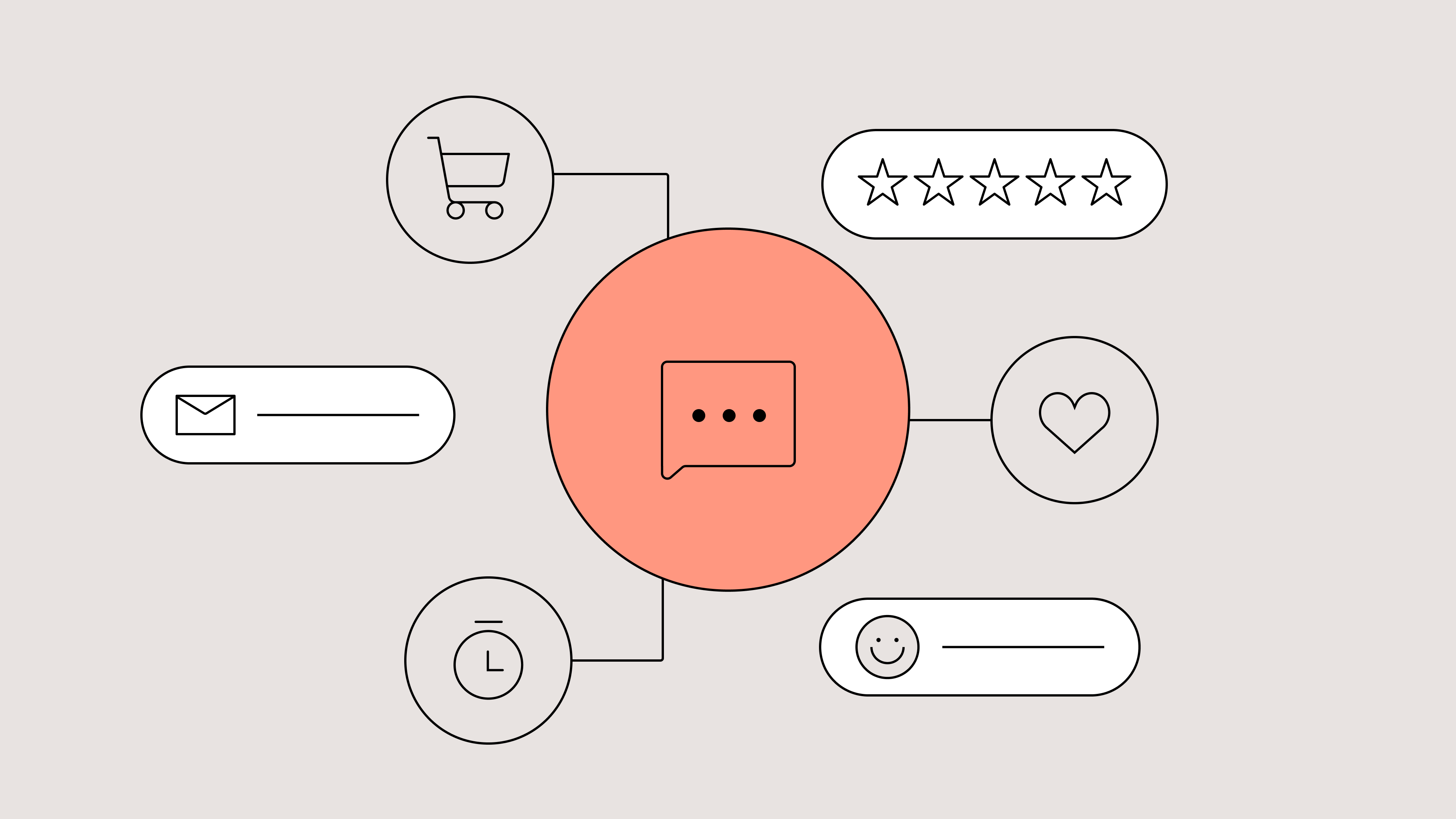
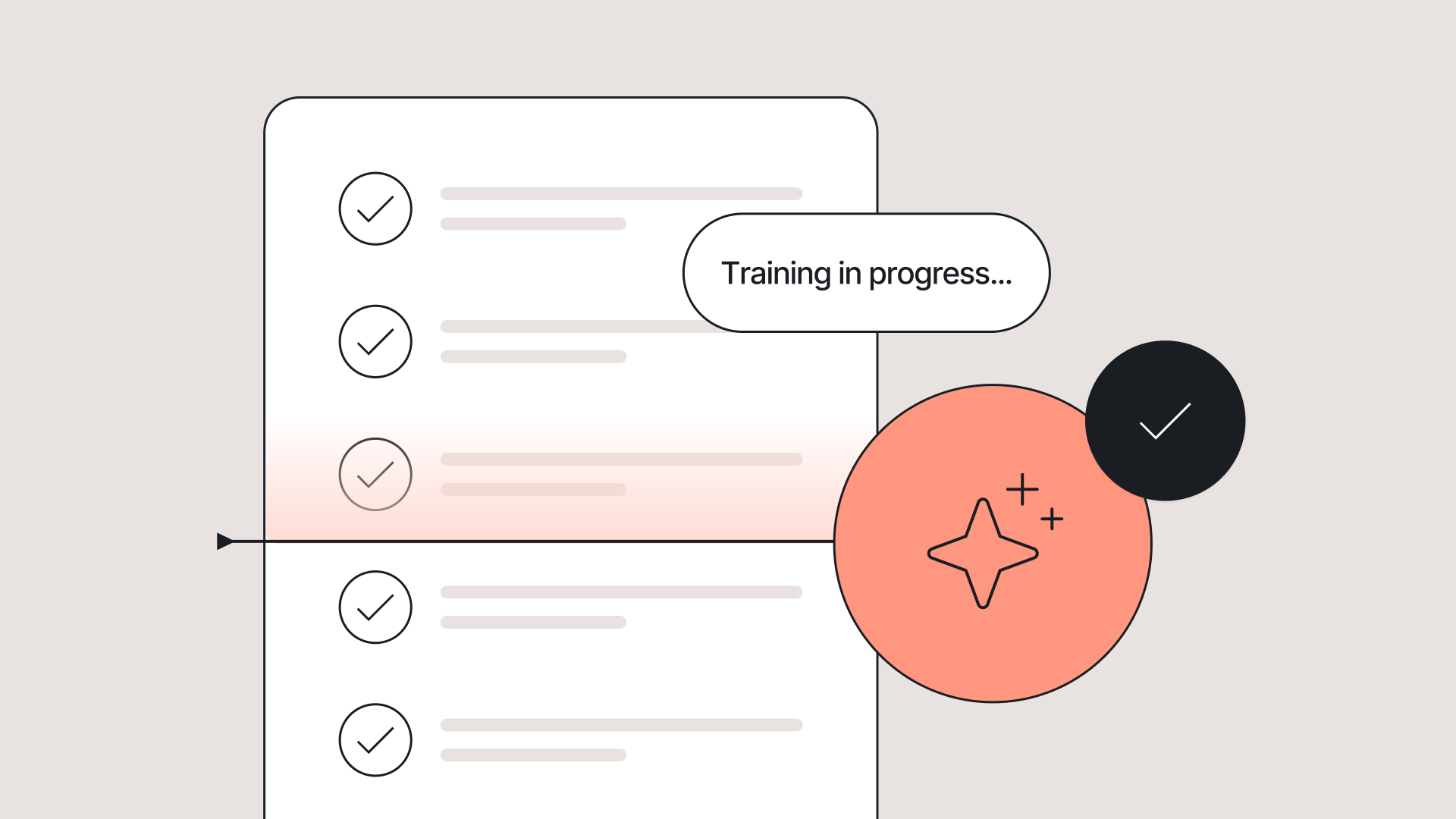

How to Make Your Help Center LLM-Friendly
TL;DR:
- You don’t need to rebuild your Help Center to make it work with AI—you just need to structure it smarter.
- AI Agent reads your content in three layers: Help Center, Guidance, and Actions, following an “if / when / then” logic to find and share accurate answers.
- Most AI escalations happen because Help Docs are vague or incomplete. Start by improving your top 10 ticket topics—like order status, returns, and refunds.
- Make your articles scannable, define clear conditions, link next steps, and keep your tone consistent. These small tweaks help AI Agent resolve more tickets on its own—and free up your team to focus on what matters most.
As holiday season support volumes spike and teams lean on AI to keep up, one frustration keeps surfacing, our Help Center has the answers—so why can’t AI find them?
The truth is, AI can’t help customers if it can’t understand your Help Center. Most large language models (LLMs), including Gorgias AI Agent, don’t ignore your existing docs, they just struggle to find clear, structured answers inside them.
The good news is you don’t need to rebuild your Help Center or overhaul your content. You simply need to format it in a way that’s easy for both people and AI to read.
We’ll break down how AI Agent reads your Help Center, finds answers, and why small formatting changes can help it respond faster and more accurately, so your team spends less time on escalations.
{{lead-magnet-1}}
How AI Agent uses your Help Center content
Before you start rewriting your Help Center, it helps to understand how AI Agent actually reads and uses it.
Think of it like a three-step process that mirrors how a trained support rep thinks through a ticket.
1. Read Help Center docs
Your Help Center is AI Agent’s brain. AI Agent uses your Help Center to pull facts, policies, and instructions it needs to respond to customers accurately. If your articles are clearly structured and easy to scan, AI Agent can find what it needs fast. If not, it hesitates or escalates.
2. Follow Guidance instructions
Think of Guidance as AI Agent’s decision layer. What should AI Agent do when someone asks for a refund? What about when they ask for a discount? Guidance helps AI Agent provide accurate answers or hand over to a human by following an “if/when/then” framework.
3. Respond and perform
Finally, AI Agent uses a combination of your help docs and Guidance to respond to customers, and if enabled, perform an Action on their behalf—whether that’s changing a shipping address or canceling an order altogether.
Here’s what that looks like in practice:

This structure removes guesswork for both your AI and your customers. The clearer your docs are about when something applies and what happens next, the more accurate and human your automated responses will feel.
A Help Center written for both people and AI Agent:
- Saves your team time
- Reduces escalations
- Helps every customer get the right answer the first time
What causes AI Agent to escalate tickets, and how to fix it
Our data shows that most AI escalations happen for a simple reason––your Help Center doesn’t clearly answer the question your customer is asking.
That’s not a failure of AI. It’s a content issue. When articles are vague, outdated, or missing key details, AI Agent can’t confidently respond, so it passes the ticket to a human.
Here are the top 10 topics that trigger escalations most often:
Rank |
Ticket Topic |
% of Escalations |
|---|---|---|
1 |
Order status |
12.4% |
2 |
Return request |
7.9% |
3 |
Order cancellation |
6.1% |
4 |
Product - quality issues |
5.9% |
5 |
Missing item |
4.6% |
6 |
Subscription cancellation |
4.4% |
7 |
Order refund |
4.1% |
8 |
Product details |
3.5% |
9 |
Return status |
3.3% |
10 |
Order delivered but not received |
3.1% |
Each of these topics needs a dedicated, clearly structured Help Doc that uses keywords customers are likely to search and spells out specific conditions.
Here’s how to strengthen each one:
- Order status: Include expected delivery timelines, tracking link FAQs, and a clear section for “what to do if tracking isn’t updating.”
- Return request: Spell out eligibility requirements, time limits, and how to print or request a return label.
- Order cancellation: Define cut-off times for canceling and link to your “returns” doc for shipped orders.
- Product quality issues: Explain what qualifies as a defect, how to submit photos, and whether replacements or refunds apply.
- Missing item: Clarify how to report missing items and what verification steps your team takes before reshipping.
- Subscription cancellation: Add “if/then” logic for different cases: if paused vs. canceled, if prepaid vs. monthly.
- Order refund: Outline refund timelines, where customers can see status updates, and any exceptions (e.g., partial refunds).
- Product details: Cover sizing, materials, compatibility, or FAQs that drive most product-related questions.
- Return status: State how long returns take to process and where to check progress once a label is scanned.
- Order delivered but not received: Provide step-by-step guidance for checking with neighbors, filing claims, or requesting replacements.
Start by improving these 10 articles first. Together, they account for nearly half of all AI Agent escalations. The clearer your Help Center is on these topics, the fewer tickets your team will ever see, and the faster your AI will resolve the rest.
How to format your Help Center docs for LLMs
Once you know how AI Agent reads your content, the next step is formatting your help docs so it can easily understand and use them.
The goal isn’t to rewrite everything, it’s to make your articles more structured, scannable, and logic-friendly.
Here’s how.
1. Use structured, scannable sections
Both humans and large language models read hierarchically. If your article runs together in one long block of text, key answers get buried.
Break articles into clear sections and subheadings (H2s, H3s) for each scenario or condition. Use short paragraphs, bullets, and numbered lists to keep things readable.
Example:
How to Track Your Order
- Step 1: Find your tracking number in your confirmation email.
- Step 2: Click the tracking link to see your delivery status.
- Step 3: If tracking hasn’t updated in 3 days, contact support.
A structured layout helps both AI and shoppers find the right step faster, without confusion or escalation.
2. Write for “if/when/then” logic
AI Agent learns best when your Help Docs clearly define what happens under specific conditions. Think of it like writing directions for a flowchart.
Example:
- “If your order hasn’t arrived within 10 days, contact support for a replacement.”
- “If your order has shipped, you can find the tracking link in your order confirmation email.”
This logic helps AI know what to do and how to explain the answer clearly to the customer.
3. Clarify similar terms and synonyms
Customers don’t always use the same words you do, and neither do LLMs. If your docs treat “cancel,” “stop,” and “pause” as interchangeable, AI Agent might return the wrong answer.
Define each term clearly in your Help Center and add small keyword variations (“cancel subscription,” “end plan,” “pause delivery”) so the AI can recognize related requests.
4. Link to next steps
AI Agent follows links just like a human agent. If your doc ends abruptly, it can’t guide the customer any further.
Always finish articles with an explicit next step, like linking to:
- A form
- Another article
- A support action page
Example: “If your return meets our policy, request your return label here.”
That extra step keeps the conversation moving and prevents unnecessary escalations.
5. Keep tone consistent
AI tools prioritize structure and wording when learning from your Help Center—not emotional tone.
Phrases like “Don’t worry!” or “We’ve got you!” add noise without clarity.
Instead, use simple, action-driven sentences that tell the customer exactly what to do:
- “Click here to request a refund.”
- “Fill out the warranty form to get a replacement.”
A consistent tone keeps your Help Center professional, helps AI deliver reliable responses, and creates a smoother experience for customers.
LLM-friendly Help Centers in action
You don’t need hundreds of articles or complex workflows to make your Help Center AI-ready. But you do need clarity, structure, and consistency. These Gorgias customers show how it’s done.
Little Words Project: Simple formatting that boosts instant answers
Little Words Project keeps things refreshingly straightforward. Their Help Center uses short paragraphs, descriptive headers, and tightly scoped articles that focus on a single intent, like returns, shipping, or product care.
That makes it easy for AI Agent to scan the page, pull out the right facts, and return accurate answers on the first try.
Their tone stays friendly and on-brand, but the structure is what shines. Every article flows from question → answer → next step. It’s a minimalist approach, and it works. Both for customers and the AI reading alongside them.
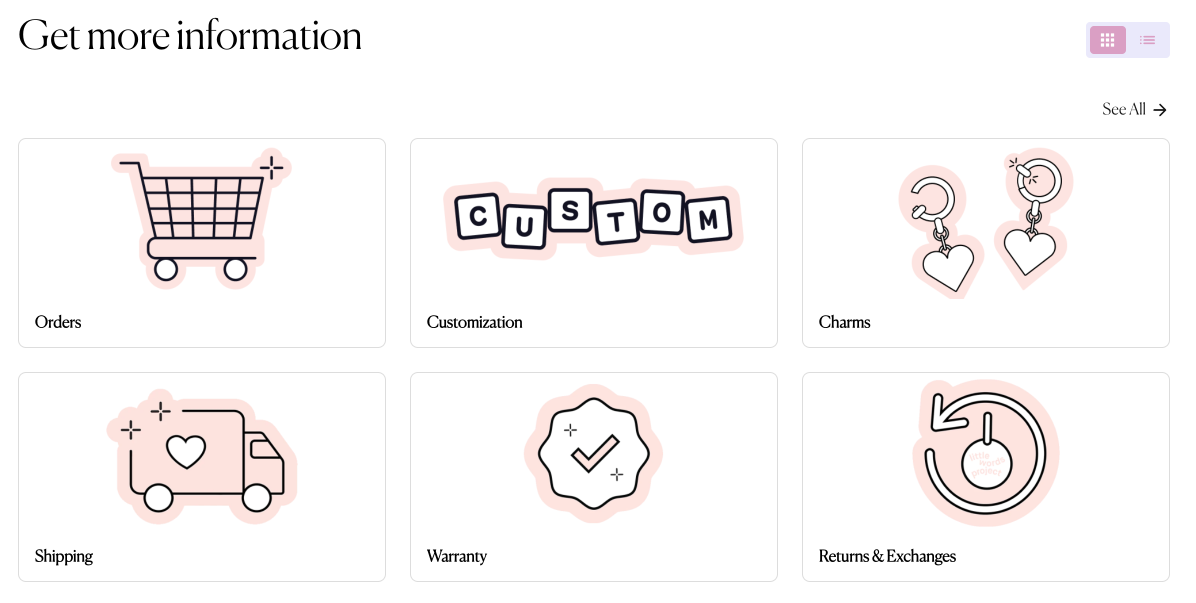
Dr. Bronner’s: Making tools work for the team
Customer education is at the heart of Dr. Bronner’s mission. Their customers often ask detailed questions about product ingredients, packaging, and certifications. With Gorgias, Emily and her team were able to build a robust Help Center that helped to proactively give this information.
The Help Center doesn't just provide information. The integration of interactive Flows, Order Management, and a Contact Form automation allowed Dr. Bronner’s to handle routine inquiries—such as order statuses—quickly and efficiently. These kinds of interactive elements are all possible out-of-the-box, no IT support needed.
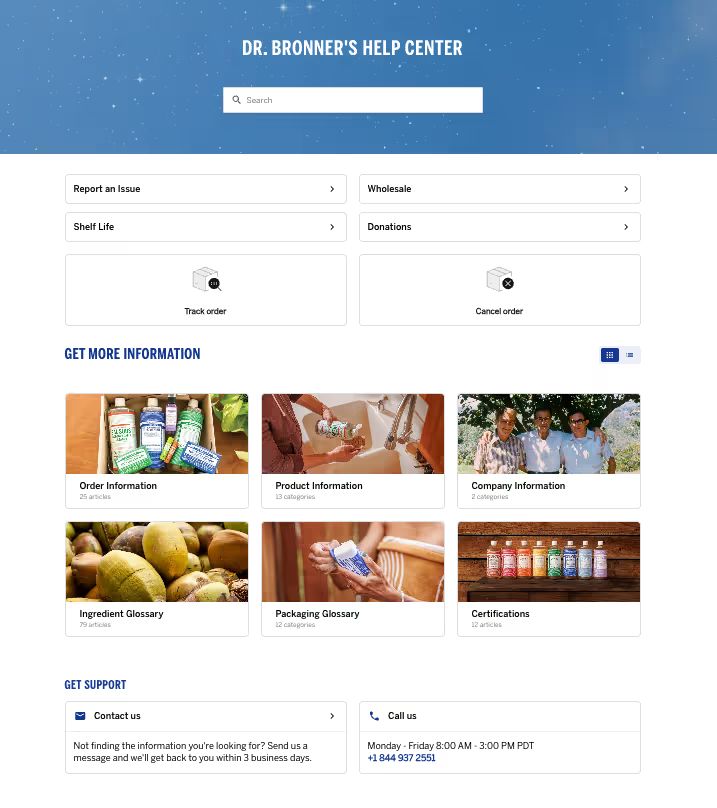
Ekster: Building efficiency through automation and clarity

When Ekster switched to Gorgias, the team wanted to make their Help Center work smarter. By writing clear, structured articles for common questions like order tracking, returns, and product details, they gave both customers and AI Agent the information needed to resolve issues instantly.
"Our previous Help Center solution was the worst. I hated it. Then I saw Gorgias’s Help Center features, and how the Article Recommendations could answer shoppers’ questions instantly, and I loved it. I thought: this is just what we need." —Shauna Cleary, Head of Ecommerce at Ekster
The results followed fast. With well-organized Help Center content and automation built around it, Ekster was able to scale support without expanding the team.
“With all the automations we’ve set up in Gorgias, and because our team in Buenos Aires has ramped up, we didn’t have to rehire any extra agents.” —Shauna Cleary, Head of Ecommerce at Ekster
Learn more: How Ekster used automation to cover the workload of 4 agents
Rowan: Clean structure that keeps customers (and AI) on track
Rowan’s Help Center is a great example of how clear structure can do the heavy lifting. Their FAQs are grouped into simple categories like piercing, shipping, returns, and aftercare, so readers and AI Agent can jump straight to the right topic without digging.
For LLMs, that kind of consistency reduces guesswork. For customers, it creates a smooth, reassuring self-service experience.
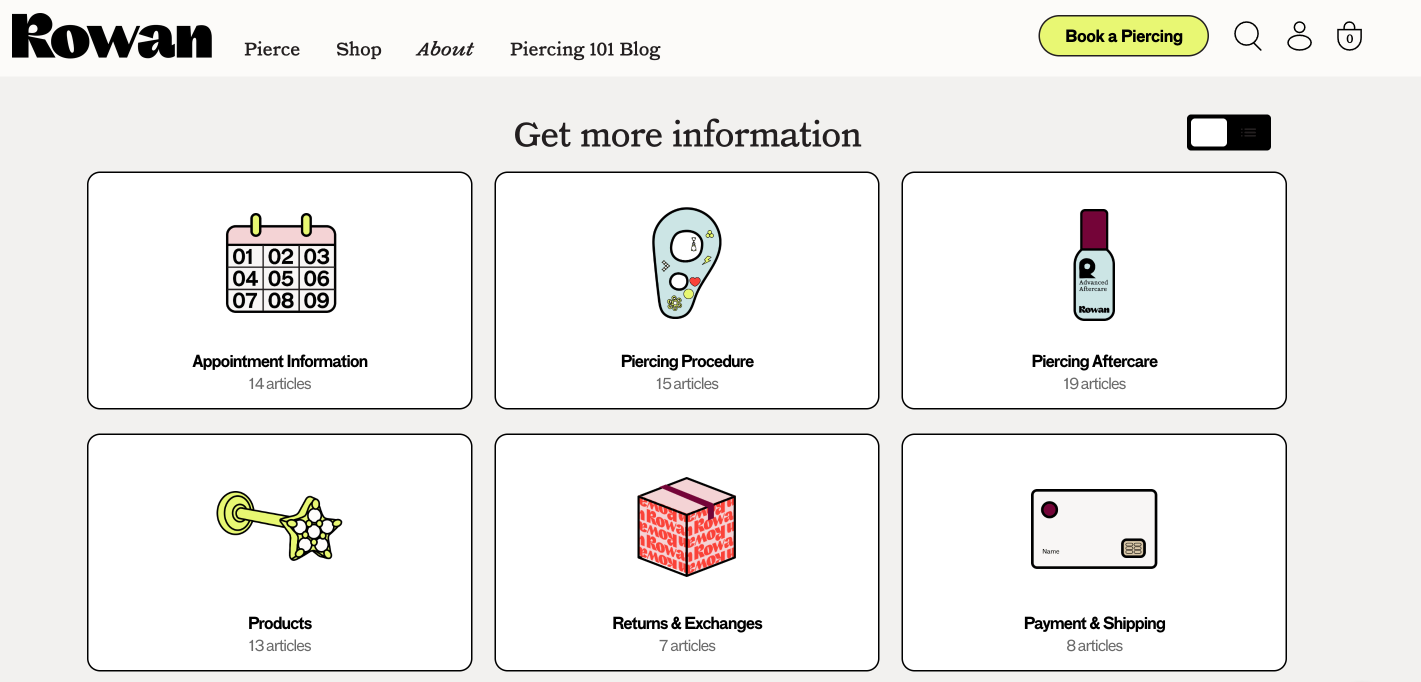
TUSHY: Balancing brand voice with automation
TUSHY proves you can maintain personality and structure. Their Help Center articles use clear headings, direct language, and brand-consistent tone. It makes it easy for AI Agent to give accurate, on-brand responses.
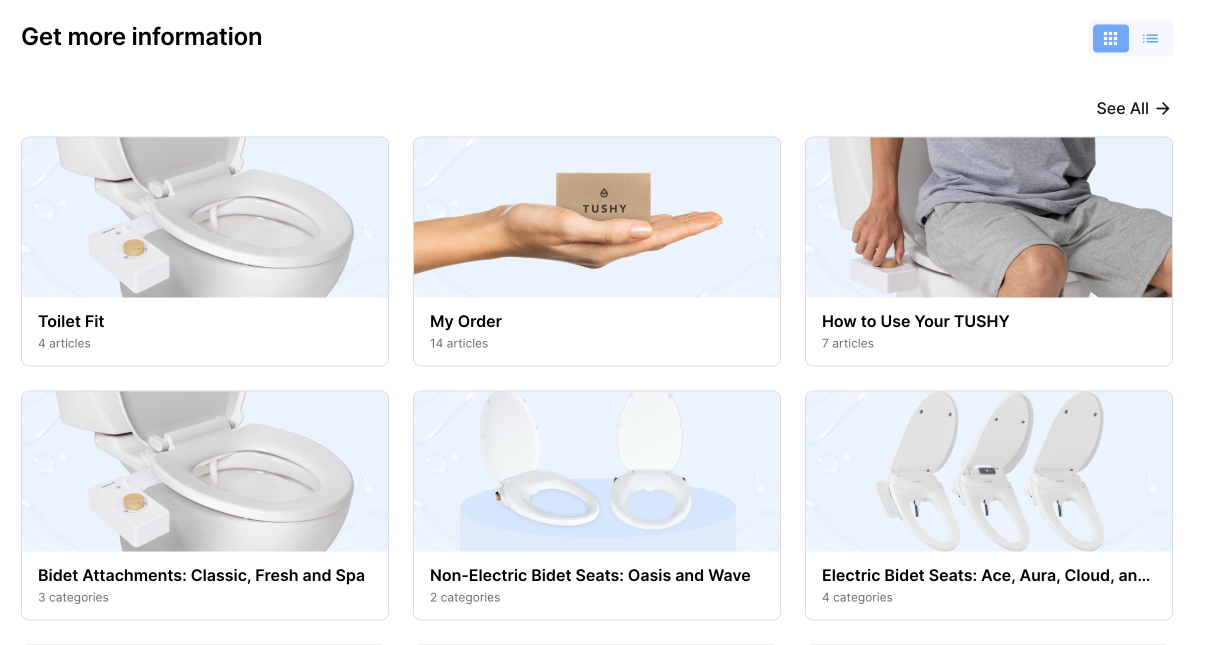
“Too often, a great interaction is diminished when a customer feels reduced to just another transaction. With AI, we let the tech handle the selling, unabashedly, if needed, so our future customers can ask anything, even the questions they might be too shy to bring up with a human. In the end, everybody wins!" —Ren Fuller-Wasserman, Senior Director of Customer Experience at TUSHY
Quick checklist to audit your Help Center for AI
Ready to put your Help Center to the test? Use this five-point checklist to make sure your content is easy for both customers and AI to navigate.
1. Are your articles scannable with clear headings?
Break up long text blocks and use descriptive headers (H2s, H3s) so readers and AI Agent can instantly find the right section.
2. Do you define conditions with “if/when/then” phrasing?
Spell out what happens in each scenario. This logic helps AI Agent decide the right next step without second-guessing.
3. Do you cover your top escalation topics?
Make sure your Help Center includes complete, structured articles for high-volume issues like order status, returns, and refunds.
4. Does each article end with a clear next step or link?
Close every piece with a call to action, like a form, related article, or support link, so neither AI nor customers hit a dead end.
5. Is your language simple, action-based, and consistent?
Use direct, predictable phrasing. Avoid filler like “Don’t worry!” and focus on steps customers can actually take.
By tweaking structure instead of your content, it’s easier to turn your Help Center into a self-service powerhouse for both customers and your AI Agent.
Make your Help Center work smarter
Your Help Center already holds the answers your customers need. Now it’s time to make sure AI can find them. A few small tweaks to structure and phrasing can turn your existing content into a powerful, AI-ready knowledge base.
If you’re not sure where to start, review your Help Center with your Gorgias rep or CX team. They can help you identify quick wins and show you how AI Agent pulls information from your articles.
Remember: AI Agent gets smarter with every structured doc you publish.
Ready to optimize your Help Center for faster, more accurate support? Book a demo today.
{{lead-magnet-2}}
TL;DR:
- Suggestion turns browsing into buying by gently guiding action instead of forcing it.
- Fewer, clearer choices reduce decision fatigue and help shoppers move forward with confidence.
- A well-timed prompt with a friendly tone can make automation feel like a real conversation.
- Good design earns trust by being subtle, approachable, and easy to engage with.
- Small, thoughtful cues create moments of connection that make shoppers feel understood.
Shopping today isn’t a linear funnel. It’s a fluid conversation. Browse → question → help → buy → return → repeat.
Every step is a dialogue between the shopper’s intent and the brand’s response.
But what bridges the gap between “just looking” and “I’m buying” isn’t persuasion or urgency — it’s suggestion: the subtle design, timing, and language cues that guide action without forcing it.
When done well, suggestion becomes the architecture of trust. It’s also the best way to make AI-powered experiences feel human-first, not tech-first.
This article explores how the power of suggestion — rooted in behavioral psychology and UX design — shapes modern conversational commerce.
Why suggestion matters in the age of conversational commerce
The average ecommerce shopper faces thousands of micro-decisions from the moment they land on a site. Which product? Which variant? Which review to trust? Which shipping method? Each one adds cognitive weight.
Psychologist Barry Schwartz coined the term The Paradox of Choice to describe how abundance often leads to paralysis. In his research, participants faced with too many options were less likely to make a choice and less satisfied when they did.
In ecommerce, that means overload costs conversions. When shoppers must evaluate too many variables, they hesitate, second-guess, or abandon.
Shoppers today expect empathy and ease, not persuasion. When you suggest rather than push, you signal empathy and support.
This is especially important for conversational commerce. Suggestion humanizes automation by making AI interactions feel like conversations rather than transactions.
When you push and persuade, you create a memorable experience for customers — but it’s not the kind you want them to remember.
One Reddit thread perfectly captures the problem: a user tried to cancel their Thrive Market membership and had to ask nine times before the chatbot complied.
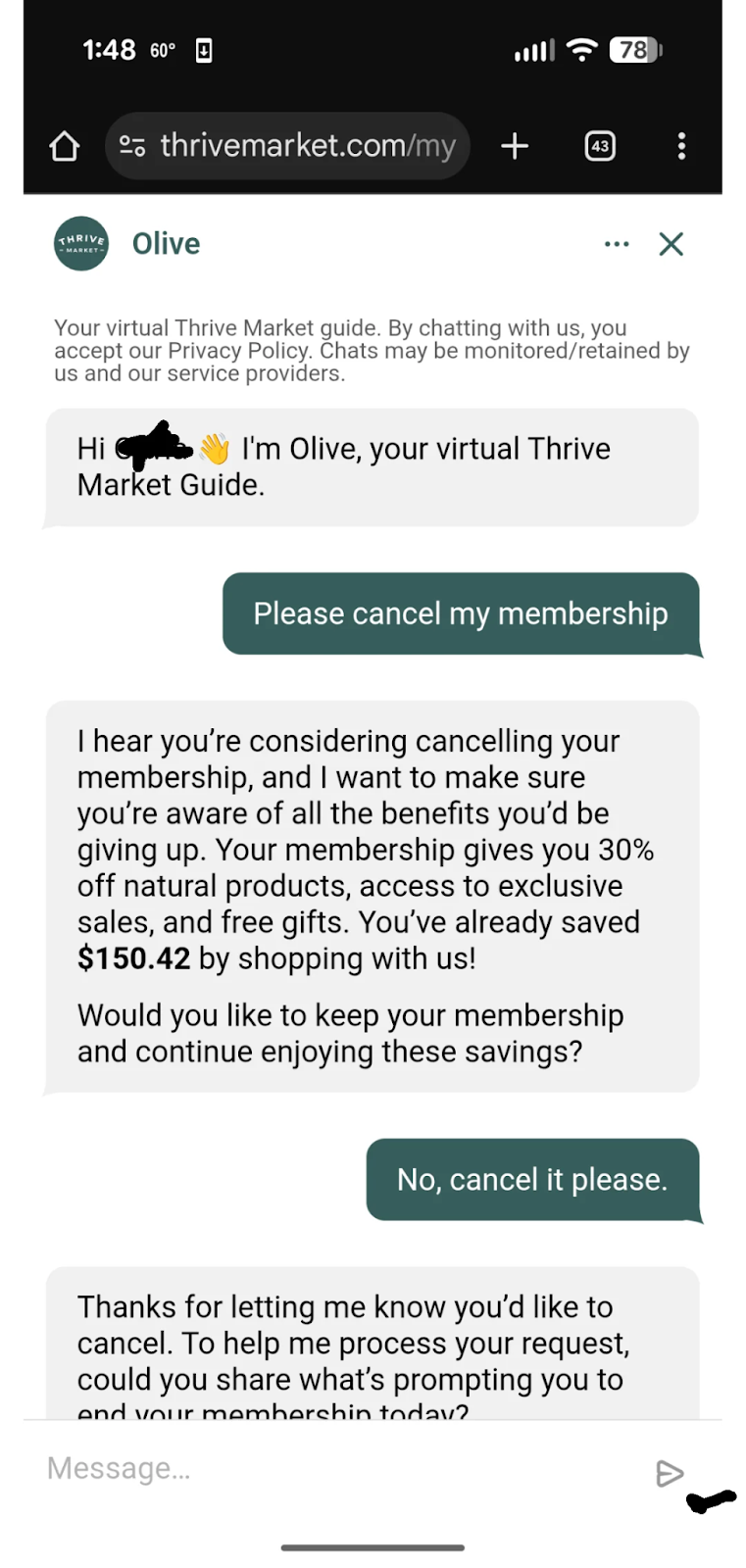
Each time, the AI assistant tried to talk them out of it (offering deals, guilt-tripping responses, or irrelevant messages) until the customer’s frustration boiled over.
The thread exploded not just because it was mildly infuriating, but because it illustrated what customers fear most about automation: a lack of empathy.
Suggestion is how you design for trust, ease, and interaction. And for ecommerce and CX professionals, suggestion bridges browsing and buying by prompting dialogue in a gentle, psychologically sound way.
5 ways to use suggestion with agentic AI
The magic of suggestion is that it works with human psychology, not against it. It bridges the space between what a shopper wants to do and what helps them do it.
That’s the foundation of the Fogg Behavior Model, developed by Stanford’s Dr. BJ Fogg. The model states that behavior happens when three things intersect:
- Motivation — the user wants to do something.
- Ability — they can do it easily.
- Prompt — they’re nudged at the right moment.
When these three align, the likelihood of action skyrockets.
In conversational commerce, suggestion is the gentle push that turns intent into interaction.
Below are five ways to apply suggestion with agentic AI (think chat, assistants, and marketing tools) to drive trust, dialogue, and conversion.
1. Build trust with a friendly invitation
A first impression shapes the entire interaction.
A greeting like “Need help?” or “Looking for something special?” signals availability without applying pressure. It’s the digital equivalent of a store associate smiling and saying, “Let me know if you need anything.”
This works because of linguistic framing, which is a form of persuasive language that subtly shapes how people interpret intent.
- Sentences using personal pronouns (“you,” “we”) increase perceived warmth and empathy.
- Questions (vs. imperatives) activate a conversational schema in the brain, inviting a cooperative response.
- Short, low-stakes phrasing signals that engagement is voluntary.
In practice, this means:
- Replace “Start chat now” with “Need a hand finding the right fit?”
- Use punctuation and tone cues that convey friendliness.
- Let the chat invite linger rather than pop up suddenly — this gives users agency.
Take a look at Glamnetic. Its shopping assistant sits at the bottom-right corner of every page. While shoppers scroll on the homepage, a prompt appears: “Shop with AI.” It’s transparent about being an AI chat, but subtle enough to be there for shoppers when they’re ready to use it at their own leisure.

Gorgias Shopping Assistant is an easy way to do this. At the right moment, Shopping Assistant appears with a greeting such as “Need help?” or “Chat with our AI!” It’s friendly, low-pressure, optional, more “Hey I’m here if you need” than “Buy now!”
2. Make decisions easier by offering fewer choices
If you’ve ever scrolled through 80 product filters and given up, you’ve experienced choice overload. This is the Paradox of Choice in action:
More options = higher cognitive effort = lower satisfaction.
Suggestion works because it reduces mental effort. When an AI assistant limits quick-reply options to just a few (say, “Long sleeve,” “Short sleeve,” “Sleeveless”), it transforms chaos into clarity.
Each small tap provides forward momentum, a concept known as the goal-gradient effect: the closer we feel to completing a goal, the faster and more positively we act.
How can you apply this to agentic AI?
- Keep quick replies between 3–5 choices — enough to feel personalized, not overwhelming.
- Present them as progressive steps, not isolated decisions (e.g., “Show me styles” → “Show me colors” → “Add to cart”).
- Always include a “Something else” or “Other” option to preserve user autonomy.
- Refresh options dynamically based on prior selections — a technique known as choice scaffolding.
Gorgias’s Shopping Assistant does this well, surfacing only the most relevant next steps. Instead of forcing open-ended typing, it guides shoppers through mini-decisions that build confidence. Here’s an example from Okanui, showing four clear options to reply to Shopping Assistant.

3. Encourage interaction with a user-friendly design
Before a shopper reads a single word of text, their brain has already judged whether your interface feels safe to engage with.
That’s the Aesthetic–Usability Effect — when people perceive something as visually appealing, they assume it will be easier and more trustworthy to use.
Design psychologist Don Norman put it best: “Attractive things work better because they make people feel better.”
Here’s why visual subtlety matters:
- Rounded edges and soft shapes signal continuity and friendliness (the human brain associates curves with safety; sharp angles with danger).
- Muted palettes and neutral contrast lower visual stress, allowing the interface to fade into the background until needed.
- Micro-animations — like a gentle glow or slide-in — trigger attention without hijacking focus.
- Minimizable elements give users a sense of control, reducing resistance to engagement.
OSEA’s product description page is a beautiful example of unintrusive design in action. The buttons have rounded edges, the 10% offer isn’t covering other page elements, and the chat sits in the bottom-right corner, making it easily accessible if a shopper has questions about the product.
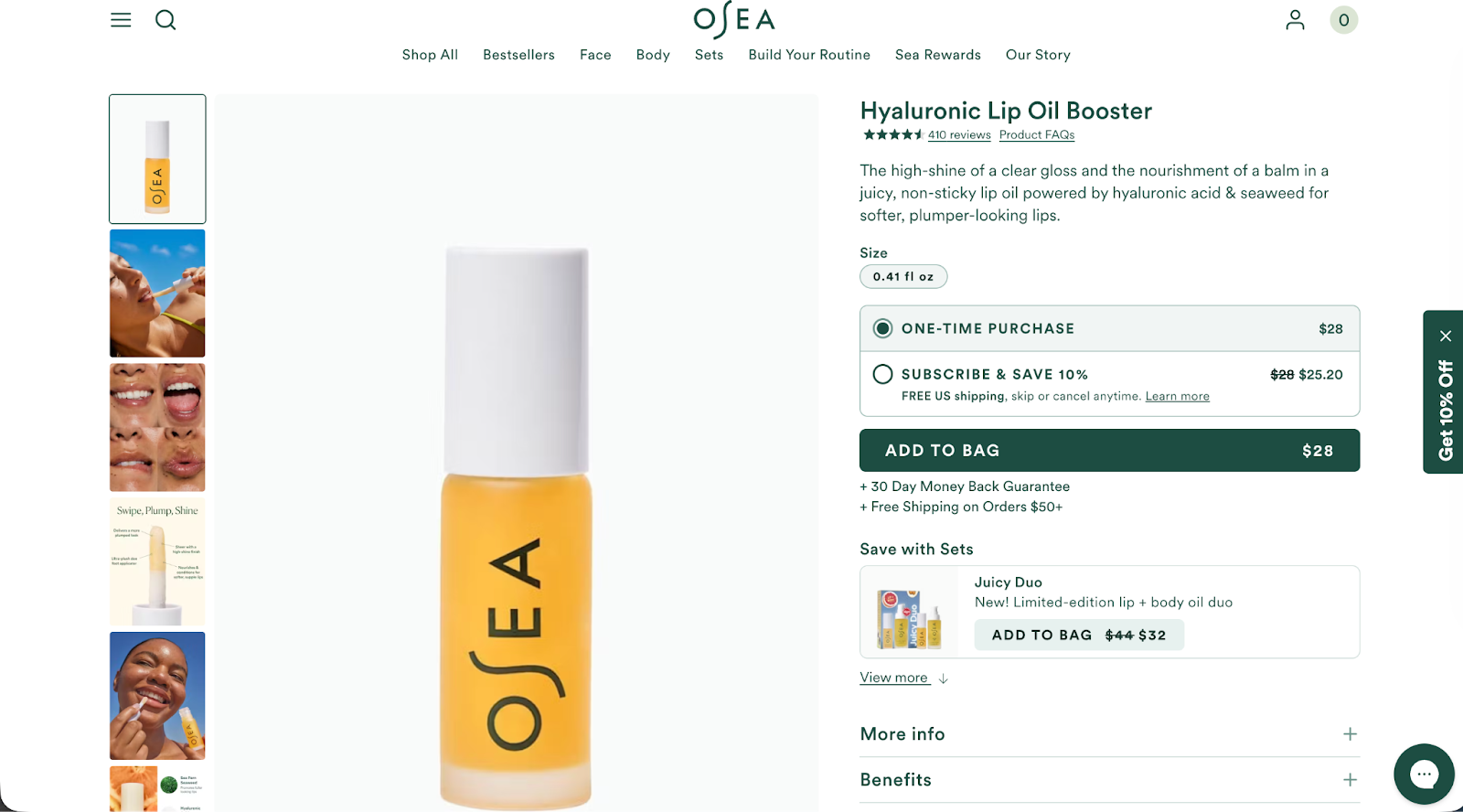
4. Match your timing to the customer’s pace
Timing is everything in suggestion-based design. Even the most thoughtful interaction will fail if it appears at the wrong moment.
That’s where the Fogg Behavior Model becomes tactical: Behavior = Motivation × Ability × Prompt
When shoppers are motivated (interested in a product) and able (engaging is easy), a well-timed prompt (chat bubble, message, or offer) turns potential into action.
But mistime it, and you risk the opposite. A chat that appears too early feels like spam. Too late, and the user’s interest window closes.
Here’s how to align the timing sweet spot:
- Use behavioral triggers: Fire prompts after meaningful engagement (e.g., 25–30 seconds on a product page, reaching 70% scroll depth, or idling for 15 seconds).
- Match prompt to context: Offer size guidance on apparel pages, warranty info near checkout, or live help on return pages.
- Respect frequency: One well-placed nudge beats five redundant ones.
- Localize timing: Adjust based on device and location. Mobile users often need faster cues due to shorter browsing sessions.
Gorgias Shopping Assistant does all of the above. Using context — such as the current page, conversational context, and cart behavior — helps the AI trigger prompts like “Need help choosing a size?” or “Have questions about shipping?”
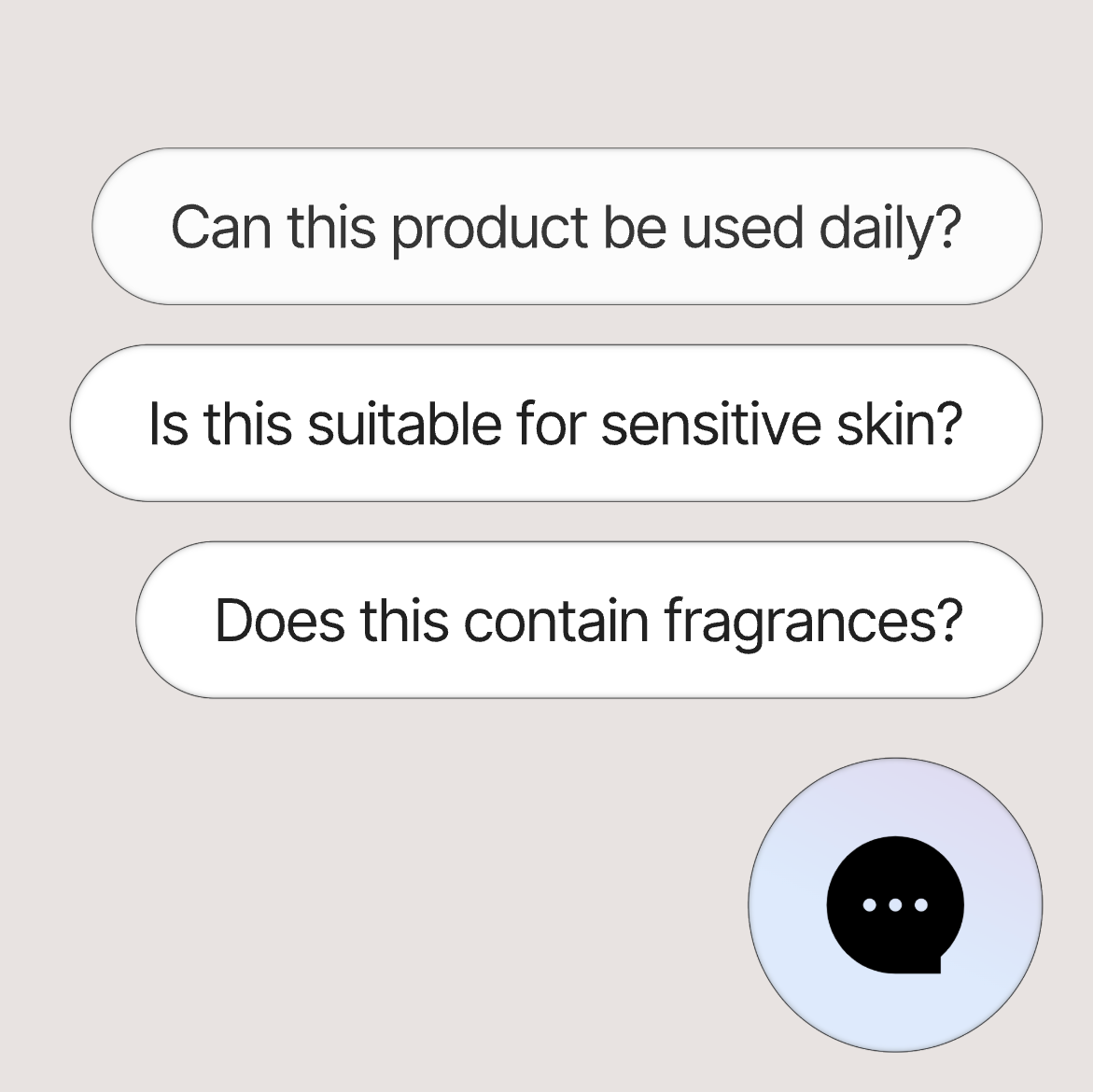
5. Aim to educate, reassure, or inspire — not just sell
Every small suggestion — a phrase, a button shape, a pause, a tone — creates what behavioral economists call a moment of micro-trust.
Individually, these moments may feel insignificant. But together, they turn a static interface into a relationship.
When greeting, choices, design, and timing align, conversation becomes the natural outcome — not the goal. That’s what conversational commerce gets right: it reframes success from “did they convert?” to “did they connect?”
For CX teams, this shift requires designing for the emotional continuity of the experience:
- Did each prompt respect the shopper’s autonomy?
- Did the interaction feel like a two-way exchange?
- Did the system adapt to intent rather than dictate it?
We love this example from Perry Ellis to drive this tip home:

Designing for trust in an age of AI
As AI continues to shape how people shop, brands face a choice: Design for control, or design for trust.
Suggestion is the path to the latter.
The right cue, delivered at the right time, reminds people that even in automated spaces, there’s still room for empathy and understanding.
Gorgias was built on the belief that great commerce starts with conversation, not conversion.
{{lead-magnet-2}}
Newsletter Signup
The best in CX and ecommerce, right to your inbox
Featured articles

How to Prep for Peak Season: BFCM Automation Checklist
TL;DR:
- Start by cleaning up your Help Center. Update your articles based on last year’s data, using plain language and clear policy details to boost self-service.
- Use automations to streamline ticket routing and support efficiency. Set rules for tagging, escalation, and inbox views, so your team can respond faster.
- Prep your macros, AI, and staffing plan in advance. Build responses for top FAQs, train AI on the right sources, and forecast agent needs to avoid burnout.
- Automate logistics, upselling, and QA to stay ahead. From showing shipping timelines to flagging low-quality responses, automation ensures smooth operations and more revenue during peak season.
Getting ready for that yearly ticket surge isn’t only about activating every automation feature on your helpdesk, it’s about increasing efficiency across your entire support operations.
This year, we’re giving you one less thing to worry about with our 2025 BFCM automation guide. Whether your team needs a tidier Help Center or better ticket routing rules, we’ve got a checklist for every area of the customer experience brought to you by top industry players, including ShipBob, Loop Returns, TalentPop, and more.
{{lead-magnet-1}}
2025 BFCM automation checklist
- Tidy up your Help Center
- Audit your docs
- Review last year’s BFCM data to find your must-have articles
- Update your policy details
- Edit content using easy-to-understand language
- Expedite your ticket routing automations
- Set up automated ticket tags
- Create an inbox view for each category
- Set escalation rules for urgent tickets
- Set up mandatory Ticket Fields
- Prep your macros and AI agent
- Write macros for your top FAQs
- Train your AI on the right sources
- Define the limits of what AI should handle
- Forecast your BFCM staffing needs
- Use ticket volume to estimate the number of agents
- Plan extra coverage with automation or outsourcing
- Run agent training sessions on BFCM protocols
- Map out your logistics processes
- Negotiate better rates and processing efficiencies
- Automate inventory reorder points
- Build contingency plans for disruptions
- Show shipping timelines on product pages
- Maximize profits with upselling automations
- Guide shoppers with smart recommendations
- Suggest alternatives when items are out of stock
- Engage hesitant shoppers with winback discounts
- Keep support quality high with QA automations
- Automate ticket reviews with AI-powered QA
- Track both agent and AI responses
- Turn QA insights into coaching opportunities
Tidy up your Help Center
Your customer knowledge base, FAQs, or Help Center is a valuable hub of answers for customers’ most asked questions. For those who prefer to self-serve, it’s one of the first resources they visit. To ensure customers get accurate answers, do the following:
- Audit your docs
- Review last year’s BFCM data to find your must-have articles
- Update your policy details
- Edit content using easy-to-understand language
1. Audit your docs
Take stock of what’s currently in your database. Are you still displaying low-engagement or unhelpful articles? Are articles about discontinued products still up? Start by removing outdated content first, and then decide which articles to keep from there.
Related: How to refresh your Help Center: A step-by-step guide
2. Review last year’s BFCM data to find your must-have articles
Are you missing key topics, or don’t have a database yet? Look at last year’s tickets. What were customers’ top concerns? Were customers always asking about returns? Was there an uptick in free shipping questions? If an inquiry repeats itself, it’s a sign to add it to your Help Center.
3. Update your policy details
An influx of customers means more people using your shipping, returns, exchanges, and discount policies. Make sure these have accurate information about eligibility, conditions, and grace periods, so your customers have one reliable source of truth.
Personalization tip: Loop Returns advises adjusting your return policy for different return reasons. With Loop’s Workflows, you can automatically determine which customers and which return reasons should get which return policies.
Read more: Store policies by industry, explained: What to include for every vertical
4. Edit content using easy-to-understand language
Customers want fast answers, so ensure your docs are easy to read and understand. Titles and answers should be clear. Avoid technical jargon and stick to simple sentences that express one idea. To accelerate the process, use AI tools like Grammarly and ChatGPT.
No time to set up a Help Center? Gorgias automatically generates Help Center articles for you based on what people are asking in your inbox.

Expedite your ticket routing automations
Think of ticket routing like running a city. Cars are your tickets (and customers), roads are your inboxes, and traffic lights are your automations and rules. The better you maintain these structures, the better they can run on their own without needing constant repairs from your CX team.
Here’s your ticket routing automation checklist:
- Tag every ticket
- Create views for each category you need (VIP, Returns, Troubleshooting, etc.)
- Set escalation rules for urgent tickets
- Set up mandatory Ticket Fields
1. Set up automated ticket tags
Instead of asking agents to tag every ticket, set rules that apply tags based on keywords, order details, or message type. A good starting point is to tag tickets by order status, returns, refunds, VIP customers, and urgent issues so your team can prioritize quickly.
Luckily, many helpdesks offer AI-powered tags or contact reasons to reduce manual work. For example, Gorgias automatically detects a ticket’s Contact Reason. The system learns from past interactions, tagging your tickets with more accuracy each time.

2. Create an inbox view for each category
Custom or filtered inbox views give your agents a filtered and focused workspace. Start with essential views like VIP customers, returns, and damages, then add specialized views that match how your team works.
If you’re using conversational AI to answer tickets, views become even more powerful. For example, you might track low CSAT tickets to catch where AI responses fall short or high handover rates to identify AI knowledge gaps. The goal is to reduce clutter so agents can focus on delivering support.
3. Set escalation rules for urgent tickets
Don’t get bogged down in minor issues while urgent tickets sit unanswered. Escalation rules make sure urgent cases are pushed to the top of your inbox, so they don’t risk revenue or lead to unhappy customers.
Tickets to escalate to agents or specialized queues:
- Lost packages
- Damaged items
- Defective items
- Failed payments
- Open tickets without a follow-up
4. Set up mandatory Ticket Fields to get data right off the bat
Ticket Fields add structure by requiring your team to capture key data before closing a ticket. For BFCM, make fields like Contact Reason, Resolution, and Return Reason mandatory so you always know why customers reached out and how the issue was resolved.
For CX leads, Ticket Fields removes guesswork. Instead of sifting through tickets one by one, you’ll have clean data to spot trends, report on sales drivers, and train your team.
Pro Tip: Use conditional fields to dig deeper without overwhelming agents. For example, if the contact reason is “Return,” automatically prompt the agent to log the return reason or product defect.
Prep your macros and AI agent
Macros and AI Agent are your frontline during BFCM. When prepped properly, they can clear hundreds of repetitive tickets. The key is to ensure that answers are accurate, up-to-date, and aligned with what you want AI to handle.
- Write macros for your most common FAQs
- Train your AI on the right sources
- Define the limits of what AI should handle
1. Write macros for your top FAQs
Customers will flood your inbox with the same questions: “Where’s my order?” “When will my discount apply?” “What’s your return policy?” Write macros that give short, direct answers up front, include links for details, and use placeholders for personalization.
Bad macro:
- “You can track your order with the tracking link. It should update soon.”
Good macro:
- “Hi {{customer_firstname}}, you can track your order here: {{tracking_link}}. Tracking updates may take up to 24 hours to appear. Here’s our shipping policy: [Help Center link].”
Pro Tip: Customers expect deep discounts this time of year. BPO agency C(x)atalyze recommends automating responses to these inquiries with Gorgias Rules. Include words such as “discount” AND “BFCM”, “holiday”, “Thanksgiving”, “Black Friday”, “Christmas”, etc.
2. Train your AI on the right sources
AI is only as good as the information you feed it. Before BFCM, make sure it’s pulling from:
- Your Help Center with updated FAQs and policies
- Internal docs on return windows, promos, and shipping cutoffs
- Product catalogs with the latest details and stock info
- BFCM-specific resources like discount terms or extended support hours
Double-check a few responses in Test Mode to confirm the AI is pulling the right information.

3. Define the limits of what AI should handle
Edge cases and urgent questions need a human touch, not an automated reply. Keep AI focused on quick requests like order status, shipping timelines, or promo eligibility. Complex issues, like defective products, VIP complaints, and returns, can directly go to your agents.
Pro Tip: In Gorgias AI Agent settings, you can customize how handovers happen on Chat during business hours and after hours.
Forecast your BFCM staffing needs
Too few agents and you prolong wait times and miss sales. Too many and you’ll leave your team burned out. Capacity planning helps you find the balance to handle the BFCM surge.
1. Use ticket volume to estimate the number of agents
Use your ticket-to-order ratio from last year as a baseline, then apply it to this year’s forecast. Compare that number against what your team can realistically handle per shift to see if your current staffing plan holds up.
Read more: How to forecast customer service hiring needs ahead of BFCM
2. Plan extra coverage with automation or outsourcing
You still have options if you don’t have enough agents helping you out. Customer service agency TalentPop recommends starting by identifying where coverage will fall short, whether that’s evenings, weekends, or specific channels. Then decide whether to increase automation and AI use or bring in temporary assistance.
3. Run agent training sessions on BFCM protocols
Before the holiday season, run refreshers on new products, promos, and policy changes so no one hesitates when the tickets roll in. Pair training with cheat sheets or an internal knowledge base, giving your team quick access to the answers they’ll need most often.
Map out your logistics processes
Expect late shipments, low inventory, and more returns than usual during peak season. With the proper logistics automations, you can stay ahead of these issues while reducing pressure on your team.
ShipBob and Loop recommend the following steps:
- Negotiate better rates and processing efficiencies
- Automate your reverse logistics
- Connect your store, 3PL, and WMS
- Automate inventory reorder points
- Show shipping timelines on product pages
1. Negotiate better rates and processing efficiencies
Shipping costs add up fast during peak season. Work with your 3PL or partners like Loop Returns to take advantage of negotiated carrier rates and rate shopping tools that automatically select the most cost-effective option for each order.
2. Automate inventory reorder points
To maintain a steady supply of products, set automatic reorder points at the SKU level so reorders are triggered once inventory dips below a threshold. More lead time means fewer ‘out of stock’ surprises for your customers.
3. Build contingency plans for disruptions
Bad weather, delays, or unexpected demand can disrupt shipping timelines. Create a playbook in advance so your team knows exactly how to respond when things go sideways. At minimum, your plan should cover:
- Weather disruptions - Do you have a backup plan if carriers can’t pick up shipments due to storms or severe conditions?
- Carrier overloads - Which alternative carriers or routes can you switch to if primary partners are at capacity?
- Inventory shortages - How will you handle overselling, low stock alerts, or warehouse imbalances?
- Demand drop-offs - How will you reallocate inventory if BFCM sales don’t match forecasts?
4. Show shipping timelines on product pages
Customers want to know when their order will arrive before they hit checkout. Add estimated delivery dates and 2-day shipping badges directly on product pages. These cues help shoppers make confident decisions and reduce pre-purchase questions about shipping times.
Pro Tip: To keep those timelines accurate, build carrier cutoff dates into your Black Friday logistics workflows with your 3PL or fulfillment team. This allows you to avoid promising delivery windows your carriers can’t meet during peak season.
Maximize profits with upselling automations
You’ve handled the basics, from ticket routing to staffing and logistics. Now it’s time to go beyond survival. Upselling automations create an end-to-end experience that enhances the customer journey, shows them products they’ll love, and makes it easy to buy more with confidence. To put them to work:
- Guide shoppers with smart recommendations
- Suggest alternatives when items are out of stock
- Engage hesitant shoppers with winback discounts
1. Guide shoppers with smart recommendations
BFCM puts pressure on customers to find the right deal fast, but many don’t know what they’re looking for. Make it easier for them with macros that point shoppers to bestsellers or curated bundles. For a more advanced option, conversational AI like Gorgias Shopping Assistant can guide browsers on their own, even when your agents are offline.
2. Suggest alternatives when items are out of stock
No need to damage your conversion rate just because customers missed the items they wanted. Automations can recommend similar or complementary products, keeping customers engaged rather than leaving them empty-handed.
If an item is sold out, set up automations to:
- Suggest similar items like another size, color, or variation of the same product.
- Highlight premium upgrades such as a newer model or higher-value version that’s in stock.
- Cross-sell and offer bundles to keep the order valuable even without the original item.
- Notify customers about restocks by letting shoppers sign up for back-in-stock alerts.
3. Engage hesitant customers with winback discounts
Automations can detect hesitation through signals like abandoned carts, long checkout times, or even customer messages that mention keywords such as “too expensive” or “I’ll think about it.” In these cases, trigger a small discount to encourage the purchase.
You can take this a step further with conversational AI like Gorgias Shopping Assistant, which detects intent in real time. If a shopper seems uncertain, it can proactively offer a discount code based on the level of their buying intent.
Keep support quality high with QA automations
During BFCM, speed alone is not enough. Customers expect accurate, helpful, and on-brand responses, even when volume is at its highest. QA automations help you prioritize quality by reviewing every interaction automatically and flagging where standards are slipping. To make QA part of your automation prep:
- Automate ticket reviews with AI-powered QA
- Track both agent and AI responses
- Turn QA insights into coaching opportunities
1. Automate ticket reviews with AI-powered QA
Manual QA can only spot-check a small sample of tickets, which means most interactions go unreviewed. AI QA reviews every ticket automatically and delivers feedback instantly. This ensures consistent quality, even when your team is flooded with requests.
Compared to manual QA, AI QA offers:
- Full coverage: Every ticket is reviewed, not just a sample.
- Instant feedback: Agents get insights right after closing tickets.
- Consistency: Reviews are unbiased and use the same criteria across all interactions.
- Scalability: Works at any ticket volume without slowing down your team.
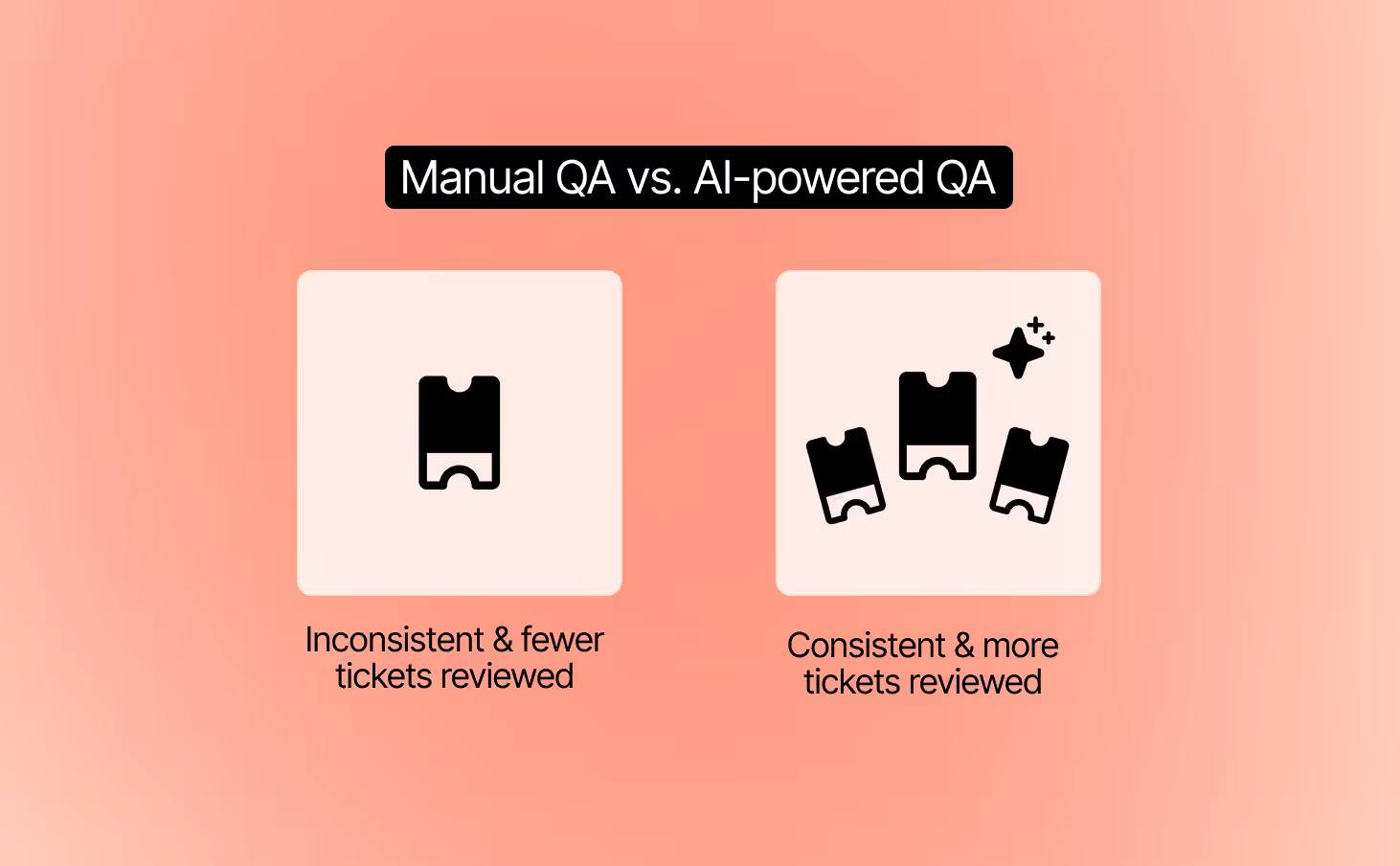
2. Track both agent and AI responses
Customers should get the same level of quality no matter who replies. AI QA evaluates both human and AI conversations using the same criteria. This creates a fair standard and gives you confidence that every interaction meets your brand’s bar for quality.
3. Turn QA insights into coaching opportunities
QA automation is not just about grading tickets. It highlights recurring issues, unclear workflows, or policy confusion. Use these insights to guide targeted coaching sessions and refine AI guidance so both humans and AI deliver better results.
Pro Tip: Pilot your AI QA tool with a small group of agents before peak season. This lets you validate feedback quality and scale with confidence when BFCM volume hits.
Give your ecommerce strategy a boost this holiday shopping season
The name of the game this Black Friday-Cyber Monday isn’t just to get a ton of online sales, it’s to set up your site for a successful holiday shopping season.
If you want to move the meter, focus on setting up strong BFCM automation flows now.
Gorgias is designed with ecommerce merchants in mind. Find out how Gorgias’s time-saving CX platform can help you create BFCM success. Book a demo today.
{{lead-magnet-2}}

AI Agent Keeps Getting Smarter (Here’s the Data to Prove It)
TL;DR:
- AI Agent is getting more accurate every month: It’s improved 14.9% this year thanks to better LLMs, constant updates, and user feedback.
- It writes more correctly than most humans: With a 4.77/5 language score, it’s nailing grammar, tone, and clarity better than human agents.
- It’s empathetic, too: AI Agent now shows more empathy and listens better than human agents.
- Brands are gaining confidence fast: Quality scores jumped from 57% to 85% in just a few months, and CX teams are noticing.
- Customers are almost as happy with AI as with humans: AI Agent’s CSAT is just 0.6 points shy of human agents’ average CSAT.
Handing trust over to AI can be intimidating. One off-brand reply and you undo the reputation and customer loyalty you’ve worked so hard to build.
That’s why we’ve made accuracy our top priority with Gorgias AI Agent.
For the past year, the Gorgias team has been hard at work fulfilling the pressing demand for accuracy and speed. AI Agent is getting smarter, faster, and more reliable, and merchants and their customers are happier with the output.
Here’s the data.
{{lead-magnet-1}}
AI Agent delivers more accurate answers than ever
This year, AI Agent’s accuracy rose from 3.55 to 4.08 out of 5, a 14.9% improvement from January. This average score is based on CX agents' ratings of AI Agent responses in the product, on a scale of 1 to 5.

In the past year, we’ve improved knowledge retrieval, added new integrations, expanded reporting features, and asked for more feedback in-product.
We saw the steadiest leap in July, right after the release of GPT-5. AI Agent began reaching levels of consistency and accuracy that agents could trust.
AI Agent writes with more linguistic precision than humans
Clear, easy-to-understand language helps people trust what they’re reading. Website Planet found that 85% more visitors bounced from a page when typos were present. That’s why we’ve made it a priority for AI Agent to respond to customers with correct grammar, syntax, and tone of voice.
The efforts have paid off: AI Agent scores a high 4.77 out of 5 in language proficiency compared to 4.4 for human agents. The result is error-free messages that are easy to read and consistent with your brand vocabulary.

AI Agent shows that empathy can be scaled
Accuracy isn’t just about saying the right thing; it’s also about how a message lands. For that reason, we track AI Agent’s communication quality. Did it reply with empathy? Did it exhibit active listening and respond with clear phrasing?
Recently, AI Agent is even scoring slightly above humans with 4.48 out of 5 in communication, compared to 4.27. This means AI Agent captures the nuance of every message by considering the background context and acknowledging customer frustration before it gives customers a solution.
AI Agent resolves every part of a customer’s question
What happens when a ticket ends without a clear answer? Customers feel neglected and leave the chat still unsure. This can make your brand look out of touch, leaving customers with the lingering feeling that you don’t care.
But don’t worry, we built AI Agent to close that loop every time: AI Agent’s resolution completeness score sits at a perfect 1 out of 1, compared to 0.99 out of 1 for human agents.
In practice, this means customers feel cared for and understood, while your team receives fewer follow-ups, giving them more time to focus on strategic, high-priority tasks.
Read more: A guide to resolution time: How to measure and lower it
Brand confidence is on the rise
Building a great product is a two-way conversation between our engineers and the people who use it. We listen, review feedback, ship changes, and measure what improves.
From January to November 2025, AI Agent quality rose from about 57% to 85%. August was the first big step up, and September kept climbing. Brands are seeing fewer low-quality or incorrect answers and more steady decisions.
This is proof that merchants and their shoppers are witnessing the improvements we’ve been making, for the better.
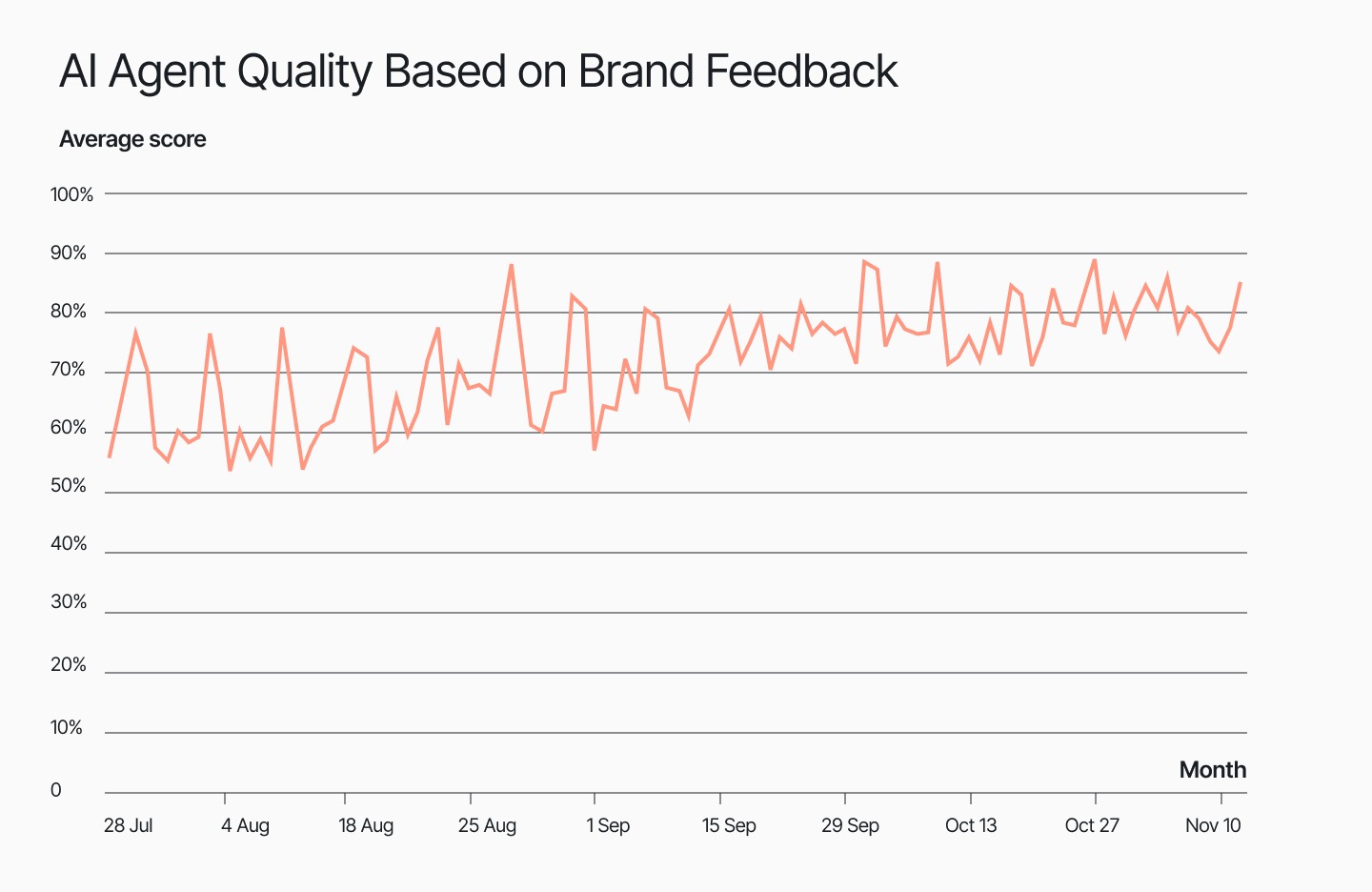
Related: The engineering work that keeps Gorgias running smoothly
Shoppers are rating AI support almost as high as human support
At the end of the day, what matters is how customers feel when they talk to support. Do they trust the answer? Do they find it helpful? Are they running into more friction with AI than without it?
Our data shows that customers are appreciating AI assistance more and more. Since the start of 2025, AI Agent on live chat has gotten a CSAT score 40% closer to the average CSAT of human agents. For email, the gap has narrowed by about 8%.
The goal is to eventually achieve a gap of zero. At this point, AI’s support quality is indistinguishable from that of humans. To get there, we’re focusing on practical improvements like accuracy, clear language, complete answers, and better handoff rules.

How we measure CSAT gap: The CSAT gap is calculated by subtracting AI CSAT from human CSAT. When the number is closer to zero, AI is catching up. When it’s negative, AI is still below human results.
Reliable AI interactions start with accuracy
Behind every accurate AI reply is a team that cares about the details. AI Agent doesn’t make up answers—it follows what you teach it. The more effort your team puts into maintaining an up-to-date Help Center and Guidance, the better the customer experience becomes.
As we look ahead to 2026, we’re focused on fine-tuning knowledge retrieval logic, refining Guidance rules, and continuously learning from feedback from you and your customers.
We’re proud of the strides AI Agent continues to make, and can’t wait for more brands to experience the accuracy for themselves.
Want to see how AI Agent delivers exceptional accuracy without sacrificing speed? Book a demo or start a trial today.
{{lead-magnet-2}}
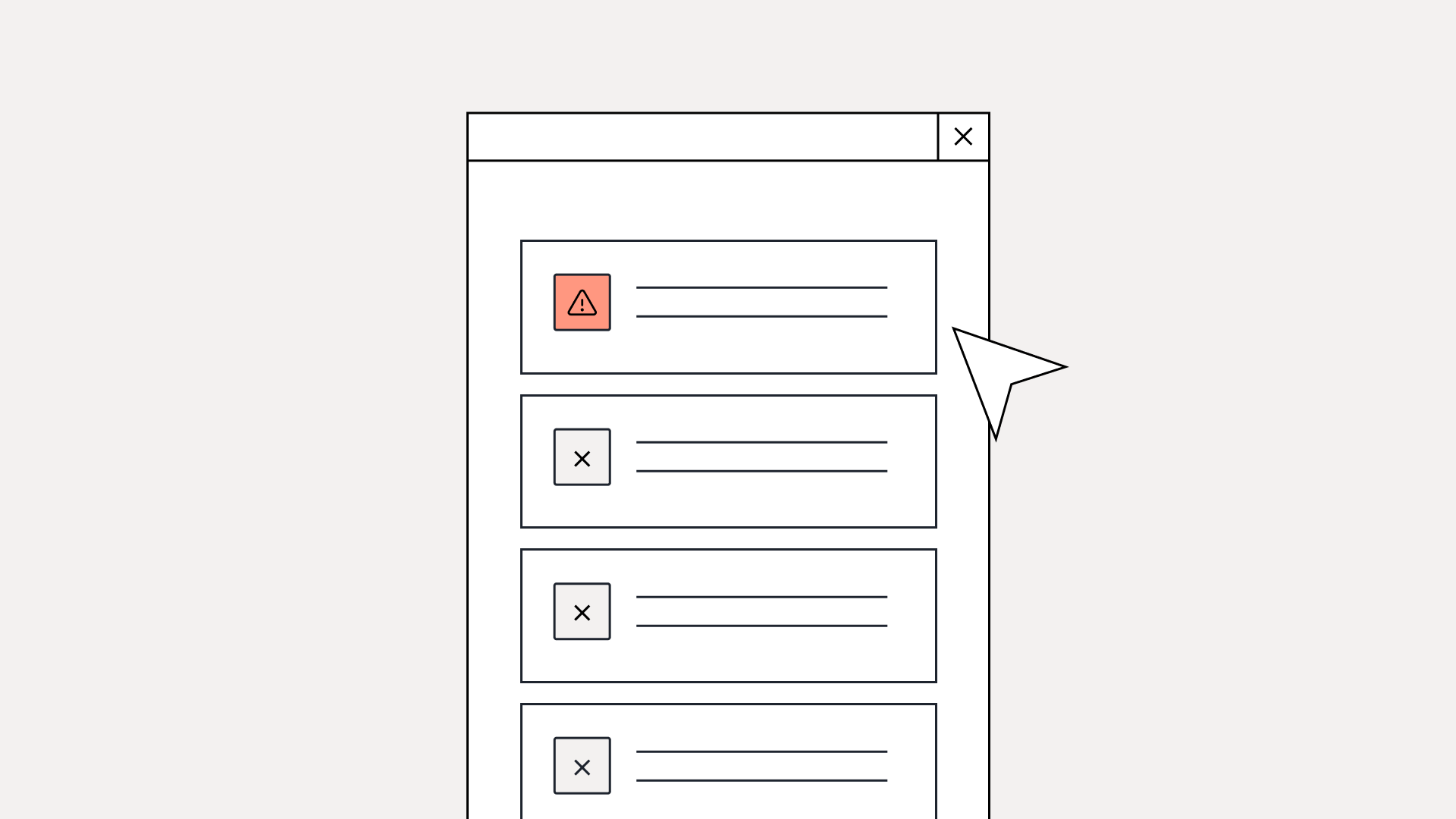
Why Faster Isn’t Always Better: The Pitfalls of Fast-Only Customer Support
TL;DR:
- Fast ≠ good. Chasing faster replies without accuracy or empathy leads to frustrated customers, burned-out agents, and declining CSAT.
- Speed-only AI backfires. Quick but wrong responses damage trust and increase ticket volume.
- Train your AI like a new hire. The best results come when AI learns your tone, workflows, and policies—not when it’s treated as plug-and-play.
- Balance speed with quality. Brands like Boody, Cocorico, and TUSHY show that when AI is trained thoughtfully, teams can scale automation and keep the human touch.
- Adopt an accuracy-first mindset. The future of CX belongs to brands that prioritize reliability, empathy, and consistency over being the fastest.
Speed gets all the glory in customer support. The faster the reply, the happier the customer. That’s not always true. When CX teams chase response times at the expense of accuracy or empathy, they often end up with the opposite effect. Frustrated customers, burned-out agents, and slipping CSAT are common when speed is the only priority.
As more teams adopt AI tools that promise instant results, the risk grows. Quick responses mean nothing if they’re wrong or robotic.
In this post, we’ll unpack why “fast” doesn’t always mean “good” and how an accuracy-first approach to AI leads to better support, and stronger customer relationships in the long run.
The speed trap: why CX teams fall for it
Response time has become the go-to measure of “good” support. Dashboards light up green when messages are answered in seconds, and teams celebrate shaved-down handle times.
But focusing on speed alone can create a dangerous blind spot.
When “fast” becomes the only KPI that matters, CX leaders make speed-at-all-costs decisions. They may roll out untrained AI tools, overuse canned replies, or push agents to close tickets before solving real problems.
On paper, the metrics look great. In reality, customer sentiment quietly drops.
It’s no surprise that 86% of consumers say empathy and human connection matter more than a quick response when it comes to excellent customer experience.
Fast support might satisfy your dashboard, but thoughtful, accurate service is what satisfies your customers.
Pitfall #1: Maximizing speed and sacrificing quality
A chatbot replies instantly, but gives the wrong answer. The customer follows up again, frustrated. Now your ticket volume has doubled, your agents are backlogged, and the customer’s confidence in your brand has dropped.
That’s the hidden cost of speed-first support. When teams prioritize quick replies over correct ones, CSAT falls, costs rise, and trust erodes. Customers remember the experience, not the timestamp.
They want to feel understood and confident that their issue is solved. A fast reply that misses the mark doesn’t deliver reassurance, empathy, or clear next steps. It’s not speed they value. It’s resolution, accuracy, and a sense that someone genuinely cared enough to get it right.
Bad AI answers sting more than slow ones because they feel careless. Especially when they repeat the same mistakes. Accuracy builds credibility; speed without it breaks it.
How Boody delivers high-quality replies while maintaining speed
Boody, for example, found the balance. With AI trained on their tone of voice and workflows, they reduced response times from hours to seconds while maintaining a high CSAT score and freeing agents for meaningful work.
The bamboo apparel brand uses Gorgias AI Agent to reassure the customer that someone is on the way to help, especially for urgent situations. It’s been instrumental in collecting preliminary information for more nuanced situations, like photos and product numbers for warranty claims.
As Boody’s CX Manager, Myriam Ferraty, explained the key is using AI to provide instant low-effort answers when customers need a prompt response.
“If a customer reaches out about product feedback or issues, AI Agent prompts the customer to give us all the information we need. When an agent gets to the ticket, they can jump into solution mode right away.” —Myriam Ferraty, CX Manager at Boody
Boody found a way to avoid the “fast but frustrating” trap by pairing speed with quality, and the numbers prove it:
- 99.88% faster first-response times: Boody’s AI Agent reduced average response times from 7 hours to just 31 seconds.
- 9+ hours shorter resolution times: Within one month of implementation, resolution times dropped significantly while accuracy stayed high.
- 26% of all interactions handled by AI: Their AI agent took on repetitive queries, freeing human agents for higher-value conversations.
- 10% revenue lift from support: With agents focused on community engagement and brand experience, customer interactions began driving measurable revenue.
These results show what happen when CX teams train AI thoughtfully, it can becomes a trusted extension of the support team, instead of only increasing speed booster.

Takeaway: Fast and good is possible, but only when your AI is trained, guided, and measured for precision, not just speed.
Read more: How CX leaders are actually using AI: 6 must-know lessons
Pitfall #2: Treating AI as plug-and-play
Many CX teams expect AI to “just work” out of the box. They install a shiny new tool, flip the switch, and hope it starts solving tickets overnight. But AI isn’t a magic button. It’s a new team member. And like any new hire, it needs training, context, and feedback to perform well.
Untrained AI can quickly go off-script. It might give inconsistent answers, slip into the wrong tone, or worse, hallucinate information altogether. The consequences are confused customers, damaged trust, and more cleanup work for your human agents.
AI performs best when it’s trained on your brand voice, policies, and knowledge base. The best CX teams don’t settle for default settings or cookie-cutter templates. They invest time to train their AI. That’s what turns it from a generic chatbot into a genuine brand representative.
How Cocorico’s well-trained AI led to customer trust (and laughter)
Cocorico, a French fashion brand, shows what this looks like in practice. Instead of setting AI loose, their team invested time in teaching it how to communicate naturally and on-brand. Within just a few months, they achieved:
- 48% automation rate, handling nearly half of all customer requests.
- 22-second average first-response time, without losing personalization.
At first, Cocorico’s Ecommerce Manager, Margaux Pourrain, admitted she was hesitant to trust AI, “We were apprehensive about launching AI. On the technical side, I thought, ‘Would the AI respond professionally? Would it respond appropriately? Could it create more work by requiring constant verification?’ On the customer experience side, I was nervous it would feel impersonal.”
Her doubts didn’t last long. Once trained on Cocorico’s workflows and brand tone, AI transformed how the team engaged with customers, “AI Agent responds so personally that customers often don’t realize they’re talking to AI. We’ve even seen customers interacting playfully and joking around with Maurice.”
Takeaway: With proper training and oversight, AI can become a trusted teammate that enhances customer experience rather than diluting it.
Read more: How AI Agent works & gathers data
Pitfall #3: Losing the human touch
When CX teams chase faster replies above all else, it’s easy to forget that great support involves connection. Agents and AI start focusing on closing tickets instead of solving problems.
Speed-only goals create fast but flat experiences that technically help customers but don’t feel human.
Over-automation can strip away the warmth and personality that make a brand memorable. Customers might get an answer in seconds, but if it lacks empathy or context, trust takes a hit. Research supports that brands that prioritize emotional intelligence in support interactions see stronger loyalty and retention rates.
How TUSHY keeps their AI playful, not robotic
TUSHY, the bidet brand known for its witty tone, took a more thoughtful approach to automation. With Gorgias Shopping Assistant, pre-sale questions about compatibility, installation, and recommendations are handled automatically. This frees up human agents to focus on relationship-building conversations.
As Ren Fuller-Wasserman, TUSHY’s Senior Director of Customer Experience, explained, keeping conversations authentic was central to their approach:
“Too often, a great interaction is diminished when a customer feels reduced to just another transaction. With AI, we let the tech handle the selling, unabashedly, if needed, so our future customers can ask anything, even the questions they might be too shy to bring up with a human. In the end, everybody wins!”
That human touch has paid off. TUSHY’s Shopping Assistant mirrors their playful brand voice and delivers real results:
- +20% increase in chat conversion rate overall
- 81% higher conversion rate compared with human agents
- 13× ROI from the Shopping Assistant investment
“Shopping Assistant has been a game-changer for our team, especially with the launch of our latest bidet models,” Fuller-Wasserman said. “Expanding our product catalog has given customers more choices than ever, which can overwhelm first-time buyers. Now, they’re increasingly looking to us for guidance on finding the right fit for their home and personal hygiene needs.”
Takeaway: Automation shouldn’t erase your brand’s humanity, it should amplify it. When AI is trained to reflect your tone and values, it can boost both efficiency and emotional connection.
The smarter path forward: accuracy-first AI
The future of customer support doesn’t involve being the fastest. Instead it means being the most reliable. Accuracy-first AI reframes automation from a race to respond into a strategy to build trust.
When customers get the right answer, in the right tone, every time, they’re more likely to stay loyal, even if it takes a few seconds longer.
So what does accuracy-first AI actually look like?
- Starts with training and clear guardrails: Like any new team member, your AI needs onboarding. These guardrails include context, escalation rules, and examples of what “great” looks like.
- Learns from past tickets and feedback: Continuous improvement keeps your AI sharp and aligned with evolving customer expectations.
- Reflects your tone and knowledge base: Every response should sound like you, not a generic script.
- Complements instead of replaces human agents: AI should take the repetitive load so humans can focus on empathy, problem-solving, and connection.
Accuracy-first AI is a mindset shift. Teams that treat AI as a coachable teammate, not a plug-and-play tool, will unlock faster resolutions and higher CSAT in the long run.
Read more: Coach AI Agent in one hour a week: SuitShop’s guide
Build for accuracy, instead of speed
Speed might win you a customer’s attention, but accuracy is what earns their trust. Fast replies mean little if they’re wrong, off-brand, or robotic. The real differentiator in modern CX isn’t how quickly you respond, it’s how effectively you resolve issues and make customers feel understood.
AI should enhance your team’s expertise, not replace it. Train it on your tone, coach it like a new hire, and measure it on quality as much as efficiency.
The brands that will thrive in the AI era won’t always be the fastest. They’ll be the most reliable, human, and consistent.
Looking for AI-led support that’s fast and human? Book a demo with Gorgias to see how accuracy-first automation can elevate your support.
{{lead-magnet-2}}
Further reading

How CX Leaders are Actually Using AI: 6 Must-Know Lessons
TL;DR:
- Train your AI like a new hire. Give it tone guidelines, review weekly, and keep refining to stay on-brand.
- Adapt AI to real customer behavior. Adjust tone and timing to improve satisfaction, even if the answer stays the same.
- Use AI to drive sales, not just support. Top brands use it to answer product questions and guide pre-purchase decisions.
- Start small and improve as you go. Begin with one common question and test often to build momentum.
If you’ve been side-eyeing AI and wondering if it’s just hype, you’re not alone. A lot of CX leaders were skeptical, too:
“I used to be the loudest skeptic,” said Amber van den Berg, Head of CX at Wildride. “I was worried it would feel cold and robotic, completely disconnected from the warm, personal vibe we’d worked so hard to build.”
But fast forward to today, and teams at Wildride, OLIPOP, bareMinerals, and Love Wellness are using AI to do more than just deflect tickets. They’re…
- Cutting costs without cutting corners
- Driving revenue before a customer even checks out
- Delivering fast, on-brand, human-feeling support at scale
Here are six lessons you can steal from the brands doing it best.
{{lead-magnet-1}}
1. Think of AI as your sidekick
We need to get one point across clearly: AI isn’t about replacing your support team.
For brands with lean CX teams, burnout is a serious problem. And it’s one of the biggest reasons AI adoption is accelerating.
“I was constantly seeing the same frustrating inquiries—sponsorship asks, bachelorette party freebies, PR requests… 45% of our tickets were these kinds of messages,” said Nancy Sayo, Director of Consumer Services at global beauty brand, bareMinerals.
“Once I realized AI could handle them with kindness and consistency without pulling in my team, I was sold.”
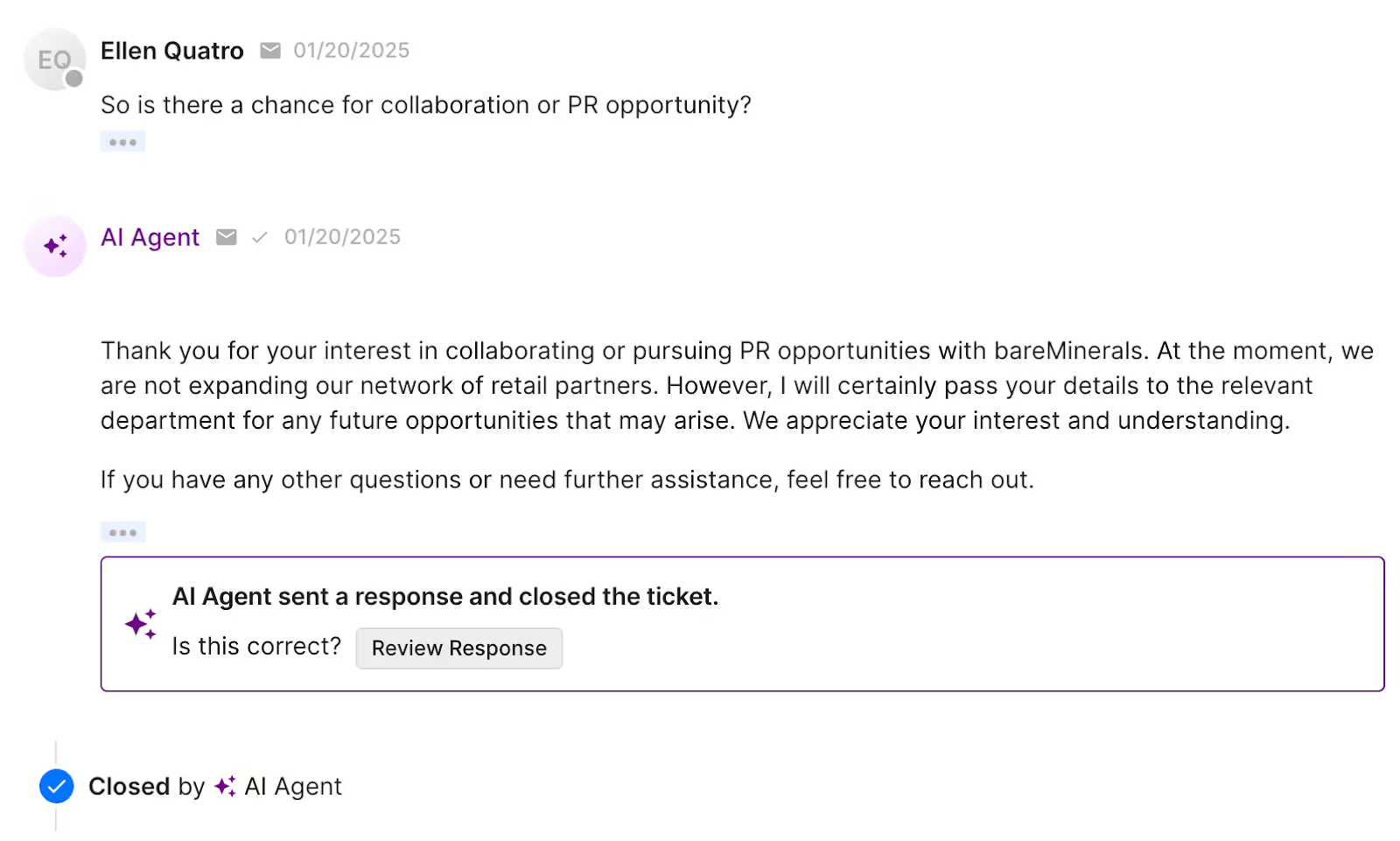
Instead of thinking of AI as a replacement, think of it as an enhancement.
It’s about making sure your CX team doesn’t burn out answering the same five questions 50 times a day.
With Gorgias AI Agent, Nancy’s team now uses automation to absorb the high-volume, low-conversion noise, freeing up their seasoned agents to focus on real revenue-driving moments.
“We use AI to handle low-complexity tickets. And we route higher-value customers to our human sales team—people who’ve been doing makeup for over a decade and really know what they’re doing.”
TL;DR? The smartest teams use AI to take the weight of repetitive tickets (“Do you ship internationally?” “Can I get free samples?”) off their shoulders so agents can focus on conversations that build trust, drive loyalty, and increase LTV.
2. Train your AI like a team member
While you can get started with AI quickly for simple queries, we don't recommend using it “out of the box.” And honestly, that’s a good thing.
Brands that “set it and forget it” are missing the point. Because if you want AI to sound exactly like your brand—not like every other chatbot on the internet—you need to give it the same context you’d give a new hire.
Amber van den Berg, Head of Customer Experience at baby carrier brand Wildride, wrote out detailed tone guidelines, including:
- Dos and don’ts for customer conversations
- Approved Dutch-to-English translations
- Example replies for nuanced, emotional questions
- Pre-written macros for product recs and delivery issues

“Lisa, our AI agent, is basically a super well-trained intern who never sleeps. I give her the same updates I give my human team, and I review Lisa’s conversations every week,” said Amber. “If something feels off-brand, too robotic, or just not Wildride enough, I tweak it.”
The feedback never stops, and that’s what makes Lisa so effective.
Related: Meet Auto QA: Quality checks are here to stay
3. Let AI mirror the pacing of real conversations
Even when AI gets it right, customers might not always feel like it did. Especially if the tone of voice is off or if your customer base just isn’t used to automation.
“Our CSAT was low at first,” said Nancy Sayo of bareMinerals. “Even if the response was accurate and beautifully written, our older customers just didn’t want to interact with AI.”
So Nancy’s team adapted. Rather than giving customers a blunt “no” to product requests, they restructured the flow:
“If someone asked for free product, we’d say, ‘We’ll send this to the team and follow up.’ Then, 3-5 days later, the AI would close the loop. It softened the blow and made customers feel heard—even if the answer didn’t change.”
That simple tweak raised CSAT and created a better customer experience without requiring a human to step in.
Inside Gorgias, teams like bareMinerals review AI performance weekly, not just to catch mistakes, but to optimize for tone, satisfaction, and brand feel. They use:
- CSAT reporting to spot dips in sentiment
- Conversation analytics to flag where AI may be losing trust
- Macro editing to quickly adjust common replies
AI gives you the flexibility to test, tweak, and tailor your approach in a way traditional support channels never could.

4. Use AI to drive sales—not just support
Too many CX teams still treat AI like a glorified autoresponder. But the most forward-thinking brands are using it to guide shoppers to checkout.
“Our customers often ask: ‘Which carrier is better for warm weather?’ or ‘Will this fit both me and my taller partner?’” said Amber van den Berg, Head of CX at Wildride. “Lisa doesn’t just answer—she gives context, recommends features, and highlights small touches like the fact that a diaper fits in the side pocket.”
With Gorgias Shopping Assistant, brands can turn AI into a proactive sales assistant—answering product questions in real time, referencing what’s in the customer’s cart, and nudging them toward the best option with empathy.
5. CX insights should power the rest of your business
Great support doesn’t stop at the inbox. At Love Wellness, CX is the connective tissue between ecommerce, product, and marketing.
“We meet quarterly with our CX and ecommerce teams to review top questions, objections, and patterns,” said Mckay Elliot, Director of Amazon at Love Wellness. “That feedback goes straight into product development and PDP optimizations on both DTC and Amazon.”
But it’s not just a quarterly ritual. Feedback sharing is embedded in the culture, and they do this with a Slack channel dedicated to customer feedback.
Dropping in insights is part of the team’s daily and weekly responsibilities. It helps everyone stay close to the content, and it sparks real collaboration on what we can improve. They then use those insights to improve ad messaging and content.

Your team has so much data they can review between channels like email, SMS, chat, and social media—both compliments and complaints. You need to be willing to listen to every customer’s needs.
Read more: Why customer service is important (according to a VP of CX)
6. Don’t overthink it, start small
One of the biggest mistakes brands make with AI? Trying to do too much, too soon.
Rolling out AI should feel like a phased launch, not a switch flip. The best results come from starting simple, testing often, and iterating as you go.
“We started with one simple question—‘Do you ship internationally?’—and built from there,” said Amber van den Berg of Wildride.
“And if it doesn’t work? You can always turn it off,” added Anne Dyer, Sr. Manager of CX & Loyalty Marketing at OLIPOP. “The key is to test, review, and keep iterating. AI should enhance your human experience, not replace it.”
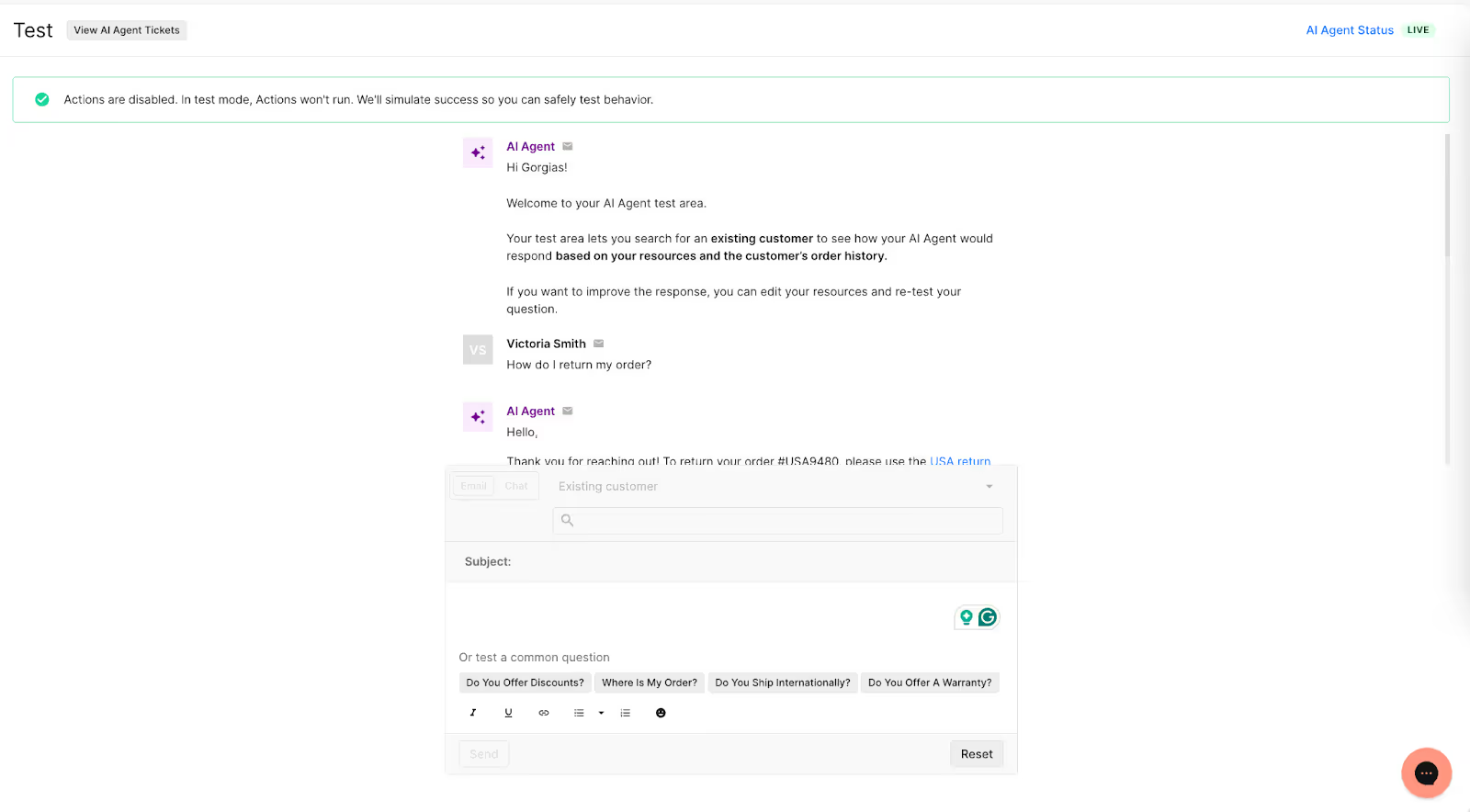
If your helpdesk supports it, start in a test environment to preview answers before going live. Then roll out automation gradually by channel, topic, or ticket type and QA every step of the way.
For most brands, the best starting point is high-volume, low-complexity tickets like:
- “Where’s my order?”
- Subscription pauses or cancellations
- Returns and exchanges
- Store policies and FAQs
You don’t need to solve everything on day 1. Just commit to one question, one channel, and one hour per week. That’s where real momentum starts.
Related: Store policies by industry, explained: What to include for every vertical
How do you measure the impact of AI in CX?
Most CX teams are used to tracking classic metrics like ticket volume and CSAT. But when AI enters the mix, your definition of success shifts. It’s not all about how fast you handle tickets anymore—it’s about how customers feel after conversations with AI, team efficiency, and the quality of every interaction.
Here are the metric CX teams used to track without AI—and what they track now with AI:
|
Metrics Tracked Before AI |
Metrics Tracked After AI |
|---|---|
|
Total ticket volume |
% of tickets resolved by AI |
|
Average first response time |
Response time by channel (AI vs. human) |
|
CSAT (overall) |
CSAT + sentiment on AI-resolved tickets |
|
Tickets per agent/hour |
Time saved per agent + resolution quality |
|
Burnout rate or turnover |
Agent satisfaction or eNPS |
The best use of AI makes space for human touch
AI isn’t here to replace your CX team. It’s here to free them up, so they can focus on deeper, more meaningful conversations that build loyalty and drive revenue.
So if you’re on the fence, start small. Train it. Review weekly. Build the muscle.
You’ll be surprised how quickly AI becomes your favorite intern.
If you want more tips from the experts featured today, you can:

Why Consolidated Doesn’t Mean Compromised: Top 3 Myths Debunked
TL;DR:
- Consolidation doesn’t mean giving up flexibility. The right all-in-one tools are modular and API-friendly, so teams can customize and integrate freely.
- You gain efficiency, not lose features. One platform means fewer gaps, less manual work, and faster support.
- It’s more affordable and faster than you think. Consolidation cuts hidden costs and delivers ROI quickly.
- Gorgias is built for ecommerce. With a deep Shopify integration and 100+ apps to connect to, it can scale with CX teams, no matter their size.
If your CX team is juggling a dozen different tools just to answer one support ticket, you’re not alone. According to our 2025 Ecommerce Trends report, 42.28% of ecommerce professionals use six or more tools every day. Plus, nearly 40% spend $5,000–$50,000 annually on their tech stack.
That’s a lot of money and a lot of tabs.
It’s no wonder “tech stack fatigue” is setting in. But while many brands are ready to simplify, there’s still hesitation around consolidation. The biggest fear is that all-in-one tools are too rigid or basic to handle the complexity of a growing business.
But the truth is, consolidation doesn’t mean compromise. When done right, it means clarity, speed, and control. It also means fewer tools, smoother workflows, and faster customer support.
Let’s bust some myths and show you what smart consolidation looks like.
{{lead-magnet-1}}
Myth #1: “All-in-one tools are too rigid”
One of the biggest blockers to consolidation is compatibility. Fifty-two percent of ecommerce professionals said they hesitate to consolidate because they’re worried about tools not playing nicely together.
That hesitation makes sense. In the past, “all-in-one” tools meant being locked into a single provider’s ecosystem, with limited integrations and rigid workflows. For CX teams managing fast-moving ops and dozens of tools, from email and returns to reviews and subscriptions, the idea of losing flexibility is a non-starter.
Reality: All-in-one tools are modular, not monolithic
Modern support platforms have moved away from monolithic systems and toward modular API-friendly designs that give brands control instead of constraints.
If you choose the right platform, consolidation doesn’t lead to a loss of functionality. Instead, it means getting a better-connected system that works smarter.
Just ask Audien Hearing who uses Gorgias’s open API to create an integration with its warehouse software to manage returns directly in Gorgias instead of a shared Google spreadsheet.
They also combine the power of Gorgias Voice with an integration to Aircall to resolve thousands of questions a day. This integration enables agents to access customer and order data directly from Gorgias while on a call—staying in one workspace.
“It's amazing that we're able to create any custom solutions we want with Gorgias's open API. Gorgias is way more than a typical helpdesk if you utilize the features it offers,” says Zoe Kahn, VP of Retention and Customer Experience at Audien Hearing.

Read more: The Gorgias & Shopify integration: 8 features your support team will love
Myth #2: “We’ll lose features we rely on”
Another common hesitation around consolidation is the risk of putting all your eggs in one basket. If everything runs through one tool, what happens when something breaks or you need to pivot?
It’s understandable, many teams worry that one tool can’t possibly do everything well. Maybe it won’t support their preferred channels, or the automation will be too limited. Or maybe they’ve been burned by a platform that promised too much and delivered too little.
Reality: All-in-one tools reduce gaps, not capabilities
In reality, consolidating gives CX teams more freedom, not less.
Instead of stitching together half a dozen tools and hoping they sync, teams using a single, well-integrated platform gain:
- A centralized view of the customer
- Cleaner workflows with fewer manual handoffs
- Less time spent training agents on multiple systems
- And fewer gaps in data or context
Under one system, your team doesn’t have to jump between tabs anymore. They can just focus on helping customers, quickly and consistently.
Take it from Osea Malibu, a seaweed‑infused skincare brand that transformed their support quality assurance process using Gorgias Auto QA. Their manual QA system was time-consuming and couldn’t scale as ticket volume surged. But the switch made impressive improvements:
- QA time reduced by 75%, from over an hour per week to just 15 minutes
- 100% of tickets now automatically quality‑checked, instead of a small manual sample
- CSAT increased (during BFCM) to 4.74/5, reflecting better consistency and faster resolutions
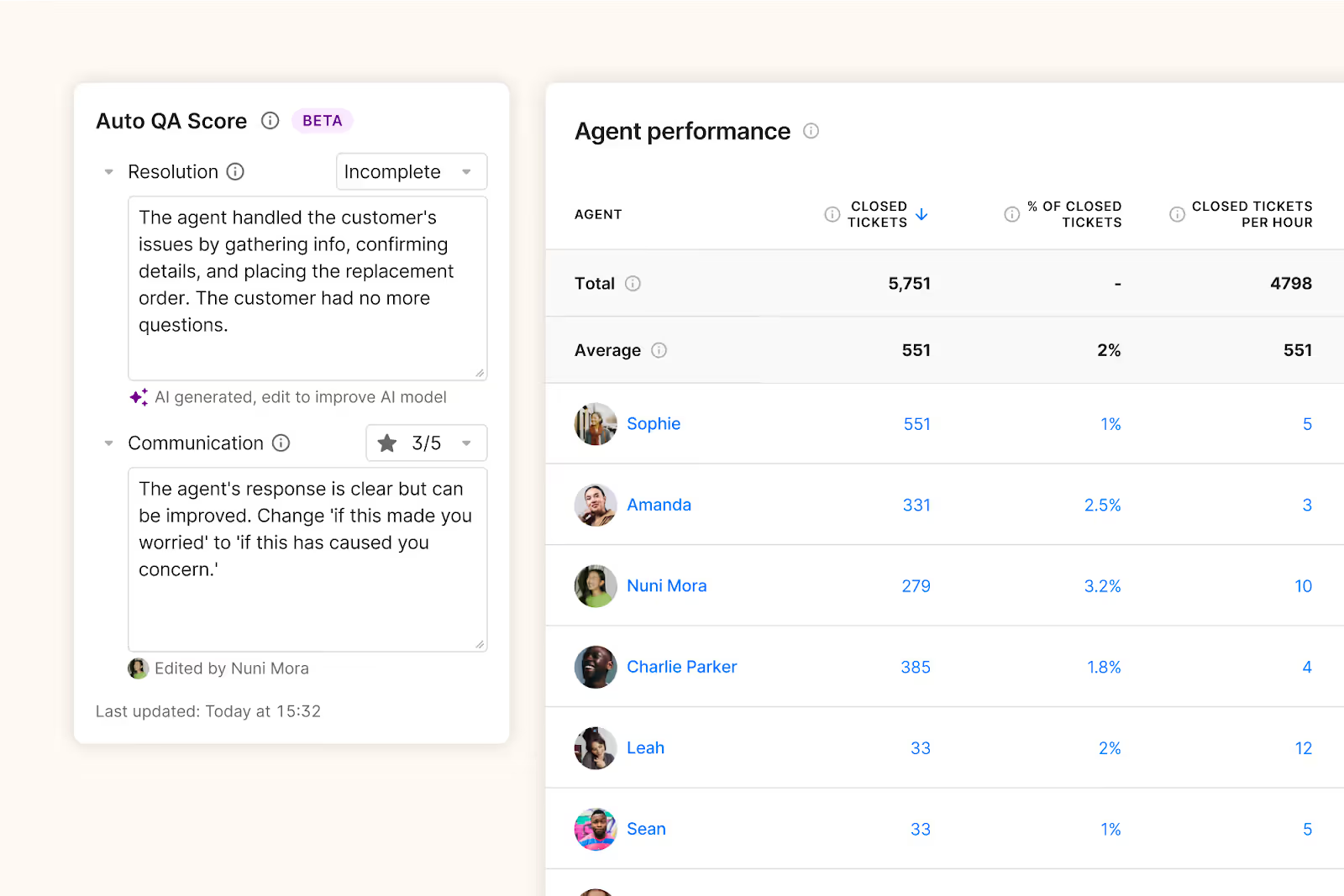
“Gorgias Auto QA saved me so much time. What used to take over an hour now only takes 15 minutes a week, and I no longer have to worry about spreadsheets.” —Sare Sahagun, Customer Care Manager at Osea Malibu
Myth #3: “Consolidation is expensive and time-consuming”
On paper, consolidation sounds smart. But 47.6% of ecommerce professionals say cost is a barrier, and 40.3% worry about the time it takes to implement a new system.
Sticking with a fragmented stack isn’t exactly cheap or quick, either. Between training new agents, managing multiple vendors, and patching together tools that don’t fully sync, the hidden costs add up fast.
Reality: Consolidation reduces overhead and busywork
It’s not actually consolidation that drains your resources—it’s complexity. And with Gorgias, simplifying pays off fast.
Trove Brands is a standout example. After centralizing their support with Gorgias, they implemented AI-powered order cancellation workflows and saw:
- 45% of tickets automated, cutting manual workload
- 70% reduction in failed order cancellations, saving costs and frustration
- 99.93% faster first response time during BFCM 2024 (from 11 hours 30 minutes to just 30 seconds)

Related: The hidden cost of not adopting AI in ecommerce
What’s the top benefit of consolidating your tech stack?
The biggest benefit of fewer tools is efficiency. It’s also a direct line to real business impact.
Constant tab-switching and duplicate data entry mean way too much time spent managing platforms instead of helping customers.
When you consolidate your tech stack, your team spends less time learning new systems, chasing down info, or waiting for one tool to sync with another.
Instead, they get everything they need in one place, faster replies, smoother workflows, and happier customers.
And that all adds up to better CSAT, lower churn, and a support team that’s finally free to focus on what matters.
What makes Gorgias different from other all-in-one platforms?
Gorgias is built specifically for ecommerce brands, with features that reflect the way CX teams actually work.
As Shopify’s only Premier Partner for customer support, we offer a native integration that pulls in key order data and context automatically, so agents have everything they need without switching platforms. That means conversations, AI, automation, revenue data, and reporting are in one place.
Our open app ecosystem allows you to connect to 100+ tools like Shopify, Klaviyo, Yotpo, and Recharge in just a few clicks. Need more customization? Our add-ons, like AI Agent and Voice let you level up at your own pace.
Whether you're handling hundreds of tickets a week or scaling globally, Gorgias adapts—so you don’t have to keep reinventing your support stack every six months.
Time to rethink your stack
Dr. Bronner’s, a globally recognized organic soap and personal care brand, made the switch from Salesforce to Gorgias to keep up with growing support demands, and it paid off fast.
Here are the results they saw with Gorgias:
- $100,000 saved in the first year by cutting licensing and developer costs
- 45% of all customer queries automated after just 2 months
- 74% reduction in ticket resolution time, powering faster support
- 11% increase in CSAT, thanks to quicker, more personalized responses
“We don’t get boxed out because we only work with Gorgias tools. Gorgias deeply understands the needs of CX, Shopify, and orders and how those tools work together so that it’s really easy for us to work across the board throughout those tools and that didn’t exist in our last setup at all,” says Emily McEnany, Senior CX Manager at Dr. Bronner’s.
If you’re still stitching together half a dozen tools to handle support, it might be time to ask: Is your tech stack helping you or holding you back?
With Gorgias, you get centralization and flexibility, so your team can move faster, serve better, and scale smarter.
Book a demo or dive into the full 2025 Ecommerce Trends report to see how other brands are rethinking their stacks.
{{lead-magnet-2}}

You’re Missing Out on Sales Without an AI Shopping Assistant—Here’s Why
TL;DR:
- Shoppers won’t wait for help—so they leave. Without instant answers, you’re losing sales to hesitation and unanswered questions.
- AI shopping assistants step in right away. They guide, recommend, and resolve concerns in real time, 24/7.
- They boost conversions and AOV. Brands like Pepper and TUSHY saw up to 62% more conversions after adding one.
- They go beyond chatbots. AI assistants proactively sell, using browsing behavior to tailor messages and close more carts.
- Gorgias Shopping Assistant is built for Shopify brands. It starts conversations, mirrors your brand voice, uses browsing data, suggests products, and sends dynamic discounts.
Shoppers aren’t always going to reach out and ask the questions they have, especially if they’re going to have to wait for a response from a CX team.
That means you’re losing sales to friction, indecision, or information gaps.
In 2025, the average cart abandonment rate is 70.19%. But if you can find an AI tool that doubles as a support and sales agent, it could make all the difference.
Gorgias’s Shopping Assistant, for example, has brought a 62% uplift in conversion rate for brands that implement it.
Ahead, learn where you can leverage an AI shopping assistant to increase conversions and craft better purchase experiences.
{{lead-magnet-1}}
What is an AI shopping assistant?
An AI shopping assistant is a chat tool powered by AI to provide pre-sales support for shoppers. It can answer questions, make product recommendations, and help guide shoppers in the right direction if they’re stuck.
Gorgias's Shopping Assistant is a powerful, hyper-personalized AI tool built for Shopify brands. Unlike other AI tools, Shopping Assistant starts conversations with customers, not the other way around. It’s uniquely tailored for each customer by tracking browsing behavior during each session and remembering what shoppers say, keeping conversations natural and recommendations relevant.
It’ll also chat with shoppers in your own brand voice, as its responses are pulled right from the knowledge you feed it.
At which point do brands lose sales in the customer journey?
The stages of the customer journey where common drop-off points occur for brands that lack proactive support include:
- Discovery (casual browsing)
- Interested (considering making a purchase)
- Ready to buy (strong purchase intent)
1) Discovery (casual browsing)
There’s a big chance that shoppers—especially first-timers—have questions, but aren’t willing to wait for a human to get back to them. And when your CX team is off the clock? Customers will likely leave altogether.
An AI shopping assistant can help you engage customers right away, even outside your business hours.
Bra brand Pepper uses Gorgias Shopping Assistant to help shoppers find their perfect size. When it detects hesitation, Shopping Assistant points customers to the sizing guide.
This proactive approach creates an easy path for conversation and sets the precedent that any questions will be answered immediately, providing a better––and less confusing––experience.
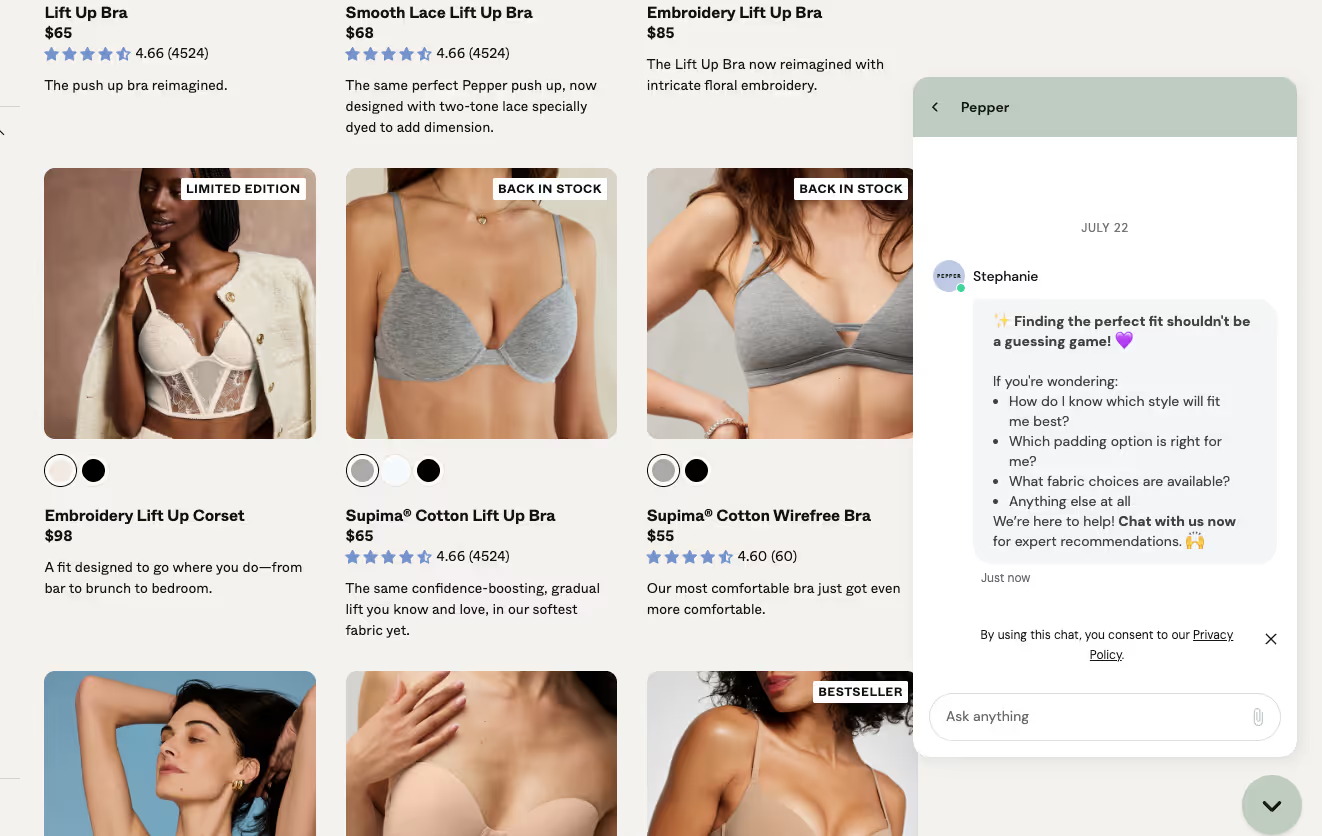
“With Shopping Assistant, we’re not just putting information in our customers’ hands; we’re putting bras in their hands,” says Gabrielle McWhirter, CX Operations Lead at Pepper.
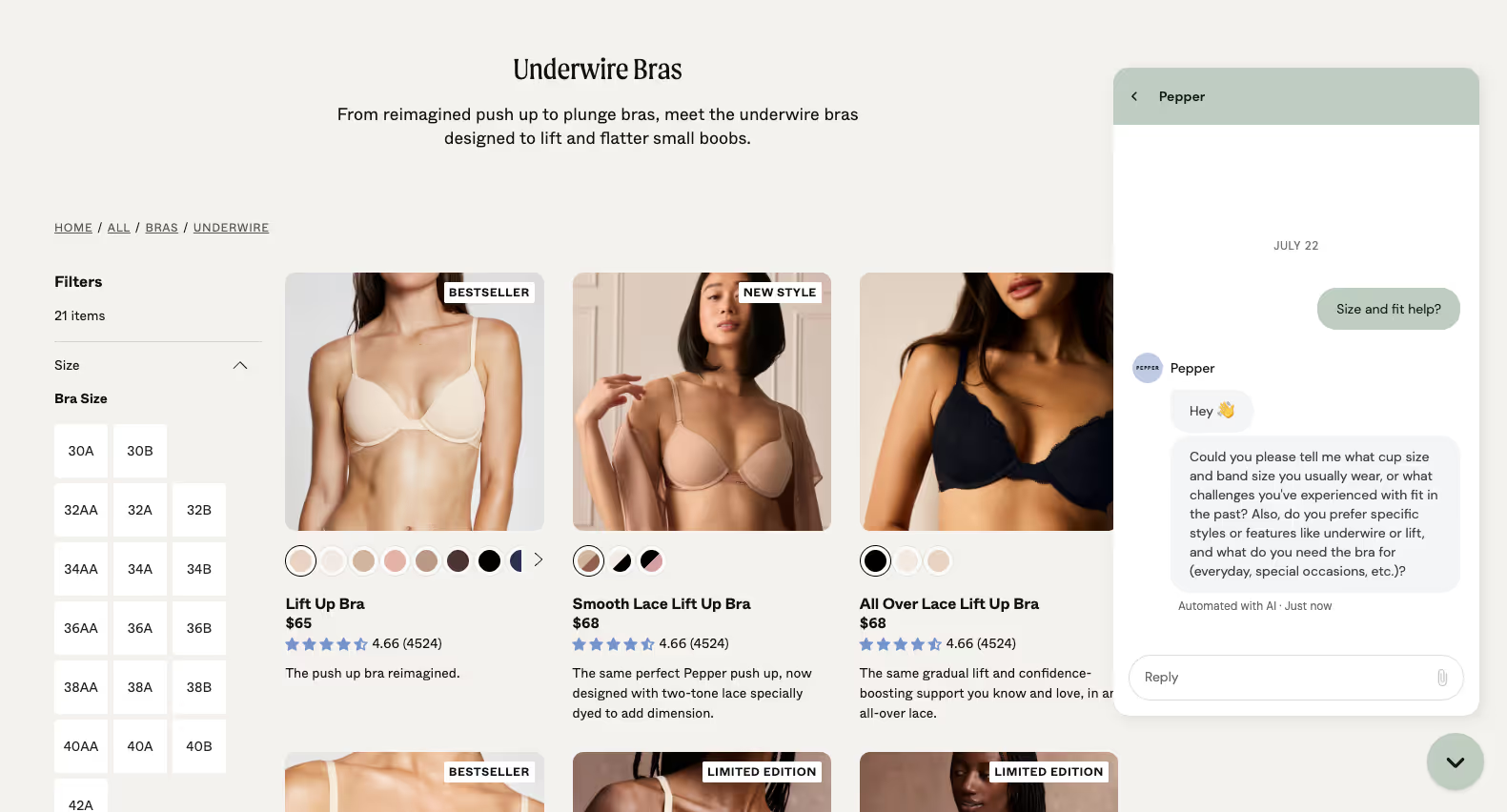
Impact these metrics 📈
For shoppers in the Discovery stage, using a Shopping Assistant boosts clicks and time on site and reduces bounce rate. It does this by surfacing specific questions on relevant product pages. Pepper boosted their conversion rate by 19% with Gorgias Shopping Assistant.
Read more: How Pepper’s AI Agent automates 54% of support and converts 19% of conversations
2) Interested (considering making a purchase)
In a retail environment, a salesperson can give shoppers recommendations by asking a few questions, especially if they’re unsure of what to buy.
AI shopping assistants have the ability to mirror those in-person shopping experiences by interacting with customers in real-time to help them find their perfect match.
Shoppers can give as much (e.g., “Help! What dress is suitable for a wedding reception?”) or as little information as they’d like, and the AI shopping assistant will do the rest.
It’s possible even for questions that are slightly vague, like a customer who types in “how to make up” without any other context:
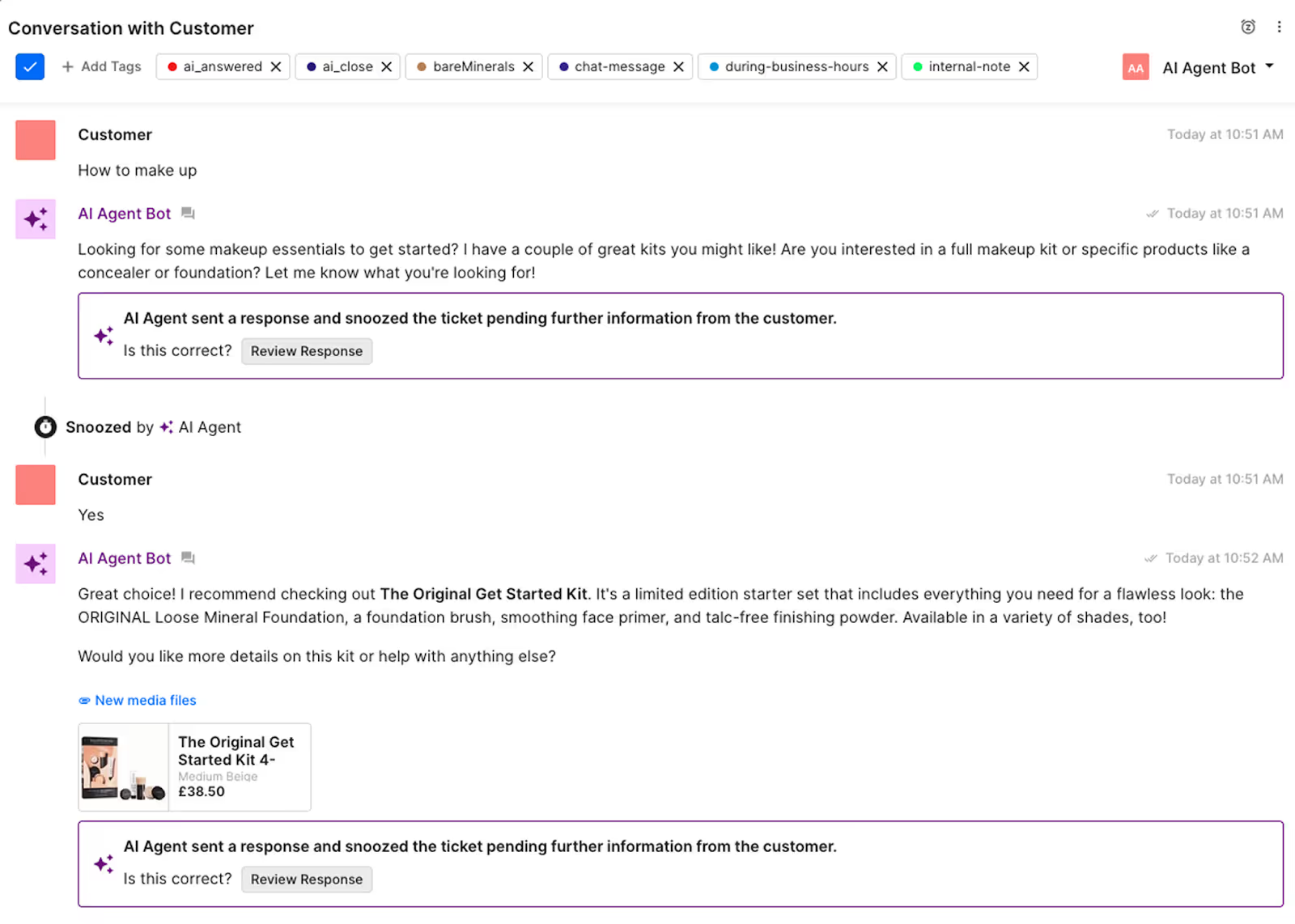
For example, jewelry shop Caitlyn Minimalist uses Shopping Assistant to recommend products, engaging interested customers and bringing them closer to a purchase.

“As a result of Shopping Assistant, we've seen a measurable lift in AOV through more meaningful customer interactions,” says Anthony Ponce, Head of Customer Experience at Caitlyn Minimalist.
“Our clients are provided the right information at the right time, creating a seamless experience that builds trust and drives confident purchases."
Impact these metrics 📈
According to data from Gorgias, email is the highest volume support channel, with ~25% of that tied to pre-sales. AI shopping assistants tackle these pre-sales asks and also upsell by recommending complementary products. This can lead to a boost in average order value (AOV) and conversion rate.
Read more: How Caitlyn Minimalist uses Shopping Assistant to turn single purchases into jewelry collections
3) Ready to buy (strong purchase intent)
The main reasons customers abandoned a cart in 2025 include:
- Extra costs (like shipping, fees, taxes) - 39%
- Delivery times were too slow - 21%
- Checkout was too complicated or long - 18%
- Didn’t like return policy - 15%
An AI shopping assistant can mitigate or resolve these issues. They resolve crucial questions—like delivery time or return policies—that need in-the-moment answers. By alleviating pre-sale concerns, they give customers the confidence to make a purchase.
For example, bidet brand TUSHY leverages Shopping Assistant to answer questions about toilet compatibility that might flush a pending sale.
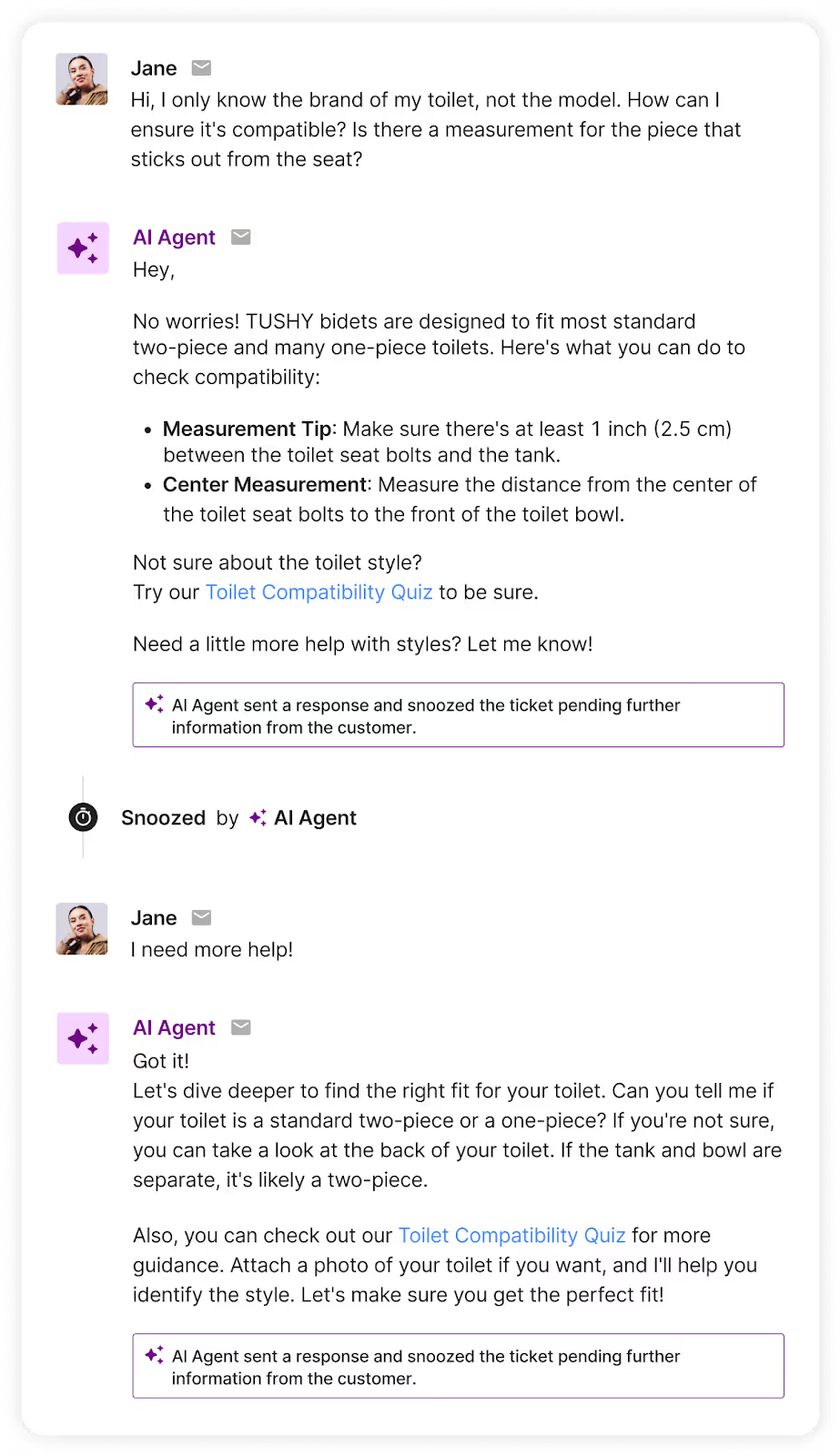
Aside from quelling customer concerns, Shopping Assistant can also send discount codes to close deals. Unlike general discount codes you find across the internet, these discounts are uniquely generated for each customer, keeping them engaged and on your site.
Impact these metrics 📈
AI shopping assistants can reduce cart abandonment rate and increase conversion rate. Gorgias Shopping Assistant adjusts to your sales strategy by sending customers discount codes that can be the final nudge to checkout.
Why traditional chatbots don’t cut it anymore
Most AI tools are built just for support. They deflect tickets and answer FAQs, but they’re not built to sell.
Shopping Assistant proves that support teams can also drive revenue by upselling, suggesting exchanges, and giving shoppers the confidence to try a brand for the first time (or to give it another shot).
Gorgias’s AI Shopping Assistant uses context-based decision making and looks for specific behavioral signals:
- Products viewed - Which product pages have they visited?
- Pages views - What pages have they explored, like FAQs, reviews or categories?
- Current page - Which page are they currently browsing?
- Purchase history – What have they bought from this brand before?
- Cart data - What items are currently in their cart?
|
Feature |
Traditional Chatbot |
AI Shopping Assistant |
|---|---|---|
|
Deflect tickets |
✅ |
✅ |
|
Answer frequently asked questions |
✅ |
✅ |
|
Upselling |
❌ |
✅ |
|
Proactively reaching out to offer support |
❌ |
✅ |
|
Use context-based signals to guide shoppers to checkout |
❌ |
✅ |
Improve conversions with Gorgias Shopping Assistant
Ultimately, the cost of not adopting AI can be higher than the investment of implementing it. 77.2% of ecommerce professionals use AI to improve their work. Why not extend those benefits to your customers?
AI Shopping Assistants help you create better customer experiences overall. These tools help reduce customer effort, increase average order value, save would-be-lost sales, and create more customer touchpoints.
Hire the always-on Shopping Assistant that never misses a sale.
{{lead-magnet-2}}

Guide More Shoppers to Checkout with Conversation-Led AI
TL;DR:
- Shopping Assistant is your new AI sales closer. It jumps in when shoppers hesitate, delivering real-time, personalized support that drives conversions.
- It boosts revenue by acting like your best salesperson. It knows when to recommend, upsell, or offer a discount, without being pushy.
- It remembers what shoppers do mid-session. That means smarter conversations, better suggestions, and bigger order values.
- It’s already delivering results. Brands using Shopping Assistant are seeing 62% more conversions, 10% higher AOV, and 5x ROI.
- You control the strategy. Customize how it promotes discounts, when it steps in, and how it speaks.
What’s the common factor between shoppers debating between products and considering a splurge? Hesitation.
Today’s shoppers are overwhelmed with choices. They don’t want to be left to figure things out on their own. They want guidance.
But most brands are missing that crucial piece of the puzzle. They lack a strategy that accompanies shoppers on their journey. A tool that encourages shoppers to proceed to checkout. And, ultimately, a customer experience devoid of a sales approach.
That’s why we built Shopping Assistant, an AI Agent that proactively engages browsers, offers context-aware product recommendations, and turns hesitation into conversions in real time.
And it’s working. Brands using Shopping Assistant are seeing a 62% uplift in conversion, 10% higher average order value, and 5x ROI.
Here’s a closer look at what’s behind the magic.
AI-powered shopping, built for sales
Most traditional chatbots passively wait for questions and deliver answers that aren’t personalized to each shopper's preferences.
Unlike these bots, Shopping Assistant reads real-time signals like pages viewed, cart contents, and conversation tone. This results in a solution that not only offers support but also offers personalized, proactive selling. This enables Shopping Assistant to continuously refine and adjust its playbook, evolving with each shopper as their journey matures.
Here’s how Shopping Assistant engages with customers across the shopping journey:
- Discovery: Gathers preferences and educates.
- Interested: Makes targeted product suggestions.
- Ready to Buy: Assists with checkout, nudges purchases with discounts.
Take this example below. When a customer vaguely asks “how to make up,” Shopping Assistant interprets it as a sign of interest in makeup products and recommends a starter kit.
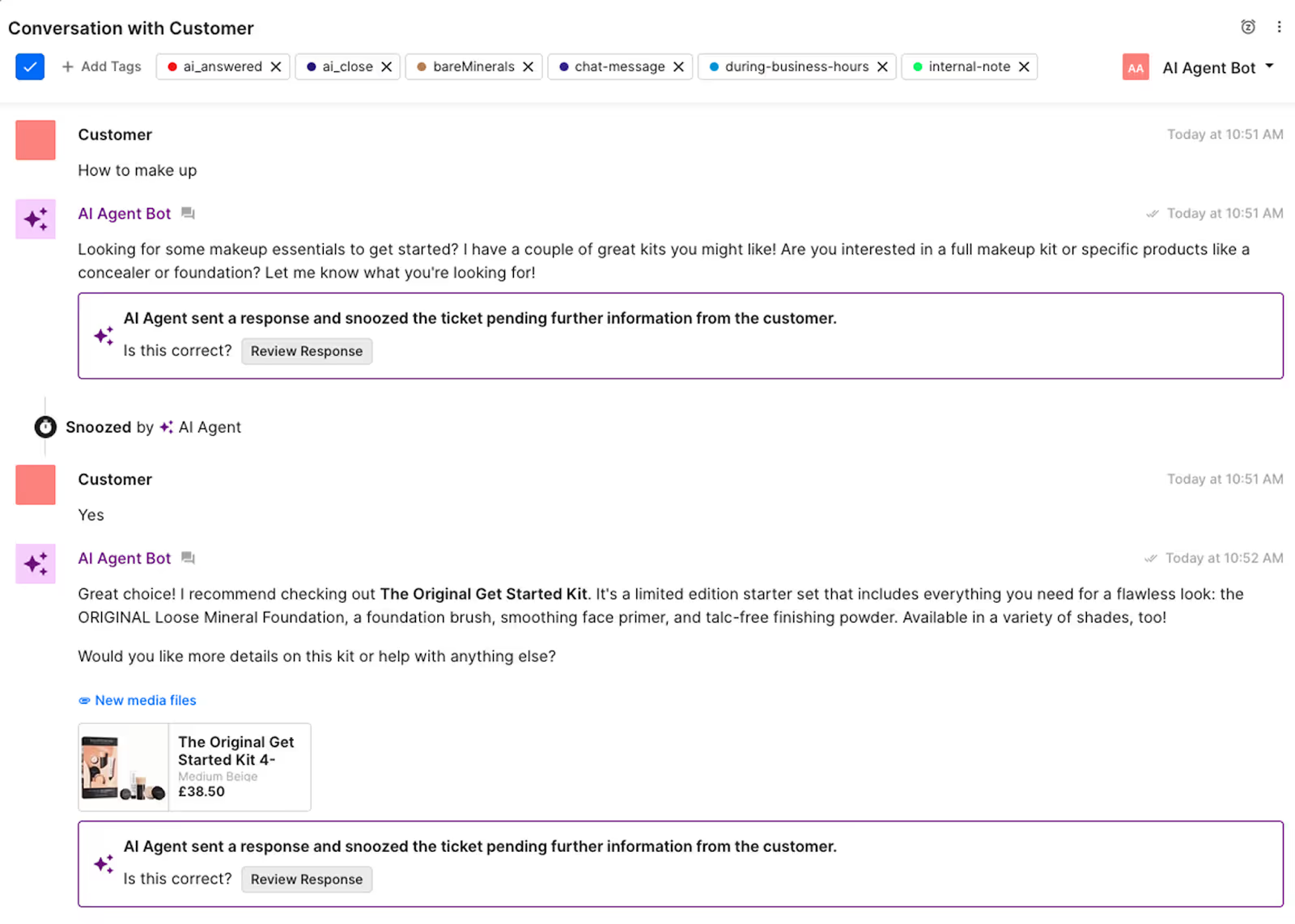
Personalization that understands you
Where traditional bots reset with every message, Shopping Assistant does the opposite. It has built-in context-aware intelligence that remembers what shoppers have clicked, viewed, and added to their cart during a session.
This enables natural, relevant, and persuasive conversations that truly resonate with each shopper. It goes beyond reading messages and observes behavior to adapt its responses.
That means it knows if someone has:
- Viewed three red lipsticks but didn’t add to cart
- Repeatedly checked sizing info for the same dress
- Added two serums to their cart after browsing dry skin FAQs
With plenty of context to work with, Shopping Assistant is not only smarter but also more profitable than the average chatbot. It drives more conversions with product recommendations and lifts average order value with timely upsells based on what’s been added to the cart or viewed.
Here’s what it looks like in action: When a customer engages through a product page, Shopping Assistant recommends a matching outfit, suggesting it’s aware of alternate product variants and the customer's likely interest in that style.
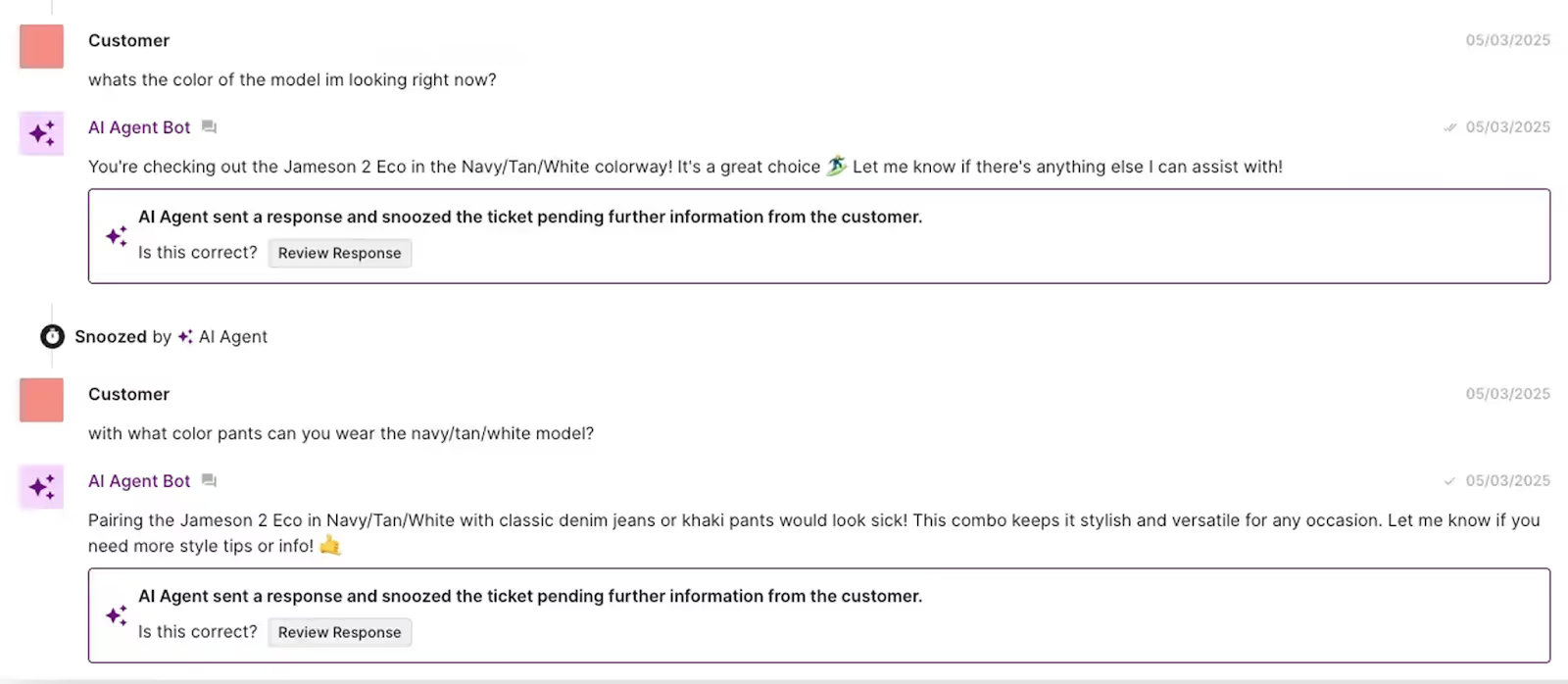
Dynamic discounts that convert without undercutting
Promotions are powerful, but they’re not one-size-fits-all.
With Shopping Assistant, merchants can define their discount strategy to align with their brand. These strategies can range from offering no deals to using aggressive promotions.
Once the strategy is set, Shopping Assistant waits for hesitation and customer intent to trigger a discount, firing it at the most conversion-worthy moment.
Proactive engagement in 3 ways
Shopping Assistant initiates conversations. It’s built to engage shoppers, spotting when they linger or show signs of confusion, stepping in with timely, personalized help.
Every second counts in ecommerce. If a shopper pauses on a product page or is left scrolling through an endless search results page, Shopping Assistant detects it in real-time and reaches out with a relevant prompt like:
- “Need help picking the right shade?”
- “Want to know our return policy before you buy?”
Here’s how Shopping Assistant reduces drop-off, builds confidence, and drives faster decision-making in three different ways.
1. Suggested product questions
Shopping Assistant automatically triggers commonly asked questions depending on the product currently being viewed. In one click, shoppers can get the answer to the question they’re curious about. This combats hesitation caused by a lack of information, resulting in more confident conversions.
2. Ask Anything Input
When shoppers land on the homepage, it’s easy to become overwhelmed and not know where to navigate. The Ask Anything Input provides an easy way to start a conversation with Shopping Assistant and get the guidance they need.
Shopping Assistant can refine its response to the customer based on the page context. For example, when the customer is on a product page, Shopping Assistant knows exactly what product is being asked about.
3. Trigger on Search
Shopping Assistant can step in to offer pinpointed help based on a shopper’s search query. Instead of scrolling through a results page, Shopping Assistant triggers a message based on what the shopper entered, offering an easier and faster way to find what they need.
Smart recommendations and relevant upsells
Shopping Assistant’s suggestions are rooted in real context: what the shopper has viewed, added to cart, or asked about. Whether they’re exploring a specific product line or revisiting a category they’ve shown interest in, Shopping Assistant delivers relevant upsells and complementary items that make sense for the customer.
This personalized approach to upselling increases cart size without feeling forced—it’s smart, seamless, and sales-driven.
Shopping Assistant can even turn vague product questions into upsell opportunities. By asking questions, it learns more about an individual to come up with recommendations that best fit their preferences.
Try Shopping Assistant today
Shopping Assistant is transforming the way shoppers engage and helping ecommerce brands sell more effectively. Through smarter conversations and real-time personalization, it turns every interaction into an opportunity to convert, build trust, and drive revenue.
{{lead-magnet-1}}

Coach AI Agent in One Hour a Week: SuitShop’s Guide
TL;DR:
- Don't just turn it on, coach it. Treating your AI Agent like a team member, not a plug-and-play tool, is what makes it truly helpful and memorable.
- One owner and one hour a week is enough to make a big impact. SuitShop’s Katy Eriks runs QA and training solo, using a repeatable system to log feedback and improve performance weekly.
- Don't forget to pause and evaluate. SuitShop temporarily turned off AI to improve their help content, making automation far more effective when it came back online.
- Let your best human agents guide your AI. Katie studied her top-performing teammate's tickets to teach AI the best responses and macros.
- Brand voice matters as much as accuracy. SuitShop's AI Agent "Max" is trained to sound warm, helpful, and on-brand. Customers even thank it by name.
The most coachable team member on your support team might not be human.
Brands that want to keep up with rising customer expectations are turning to AI to help meet demand. But as SuitShop’s Director of Customer Experience, Katie Eriks, will tell you, great results don’t come from flipping a switch.
They come from coaching.
Since implementing Gorgias AI Agent, SuitShop has reached a 30% automation rate, all while maintaining a lean CX team and giving every customer the tailored experience they expect (literally and figuratively).
“I consider myself its boss,” said Katie, who runs the entire coaching process solo. With under an hour of weekly maintenance now, SuitShop’s AI Agent runs efficiently, accurately, and on-brand.
Katie spoke at Gorgias Connect 2025 to share exactly how she got there. You can watch her full session below:
The case for coaching your AI Agent
When brands think about automation, they often imagine flipping a switch and watching repetitive tasks vanish. But in practice, it’s not that simple, at least not if you care about customer experience.
Gorgias encourages brands to treat their AI Agent like a junior teammate — someone you onboard, train, observe, and coach over time.
Brands that do this well are already seeing massive gains:
- 60%+ of customer conversations fully automated
- First response times under 30 seconds
- Consistent CSAT scores of 4.5 and above
- Major cost savings during high-volume seasons
For SuitShop, automation was about creating space for their small team to focus on specialized service. Space to scale without scaling headcount. And space to do it all without losing their voice.

Step-by-step: SuitShop’s AI coaching workflow
Katie and her team had been longtime Gorgias users, but when they turned on AI Agent in August 2023, the results were unremarkable. The responses weren’t inaccurate, but they weren’t helpful enough either.
What Katie learned was to “Be hands-on early. Use downtime to train. And never stop refining.”
So she got to work, not by replacing the tool, but by going deeper into it. Here are her coaching tips:
One owner, one hour a week
Katie made herself the sole point of contact for training and QA. That might sound like a lot, but over time, it became a light lift.
“At this point, it’s definitely less than one hour per week,” she said. “In the beginning, it was more time-consuming because I needed to create help center articles and Guidance regularly. Now I’ve got it down to a pretty quick thumbs-up, thumbs-down kind of process.”
Katie uses Monday mornings to review AI Agent tickets from over the weekend, when fewer human agents are available and AI takes the lead.
Read more: Why your strategy needs customer service quality assurance
Pause and perfect before scaling
Unlike many retail brands, SuitShop’s busiest time isn’t the holiday rush — it’s wedding season in the summer and fall. So when things quieted down in December, Katie used that time strategically.
She temporarily turned off the AI Agent to regroup.
“I decided to turn it off and really beef up our Help Center,” she explained. “I went back to the tickets I had to answer myself, checked what people were searching in the Help Center, and filled in the gaps.”
She built out content with a mix of blog knowledge, internal macros, and ChatGPT. Once she felt confident the content base was solid, she turned AI back on.
Read more: How to optimize your Help Center for AI Agent
Use data to guide your coaching plan
Once SuitShop’s foundational content was in place, Katie didn’t just sit back and hope for the best. Instead, she built a repeatable feedback loop grounded in data — one that helped her spot opportunities for improvement before they became issues.
Rather than combing through tickets at random, Katie created custom views inside Gorgias to zero in on the most impactful coaching moments:
- Low CSAT tickets: Any conversation that ended with a customer satisfaction score below expectations got flagged. These were clear indicators that something about the tone, accuracy, or clarity of the AI response had fallen short.
- High handover rates: Katie looked at the tickets AI Agent was regularly handing off to humans. Many of these were actually answerable. The handover just meant that guidance was missing, miscategorized, or too vague.
- Agent-tagged tickets: To make this scalable, Katie empowered her team to flag any strange or impressive responses from the AI. By using a tag like AI_agent_feedback, team members could drop tickets into a coaching queue without needing to write a full explanation.
To keep all of this actionable, Katie logs insights in a shared spreadsheet that functions as a live to-do list. Every row includes:
- A link to the ticket
- A summary of the issue
- The resolution (e.g., new Guidance or macro needed)
- A status tracker (not started / in progress / completed)
- A link to the resource she created in response
These insights are also available in Gorgias’s dashboard, where you can identify the top issues customers had.
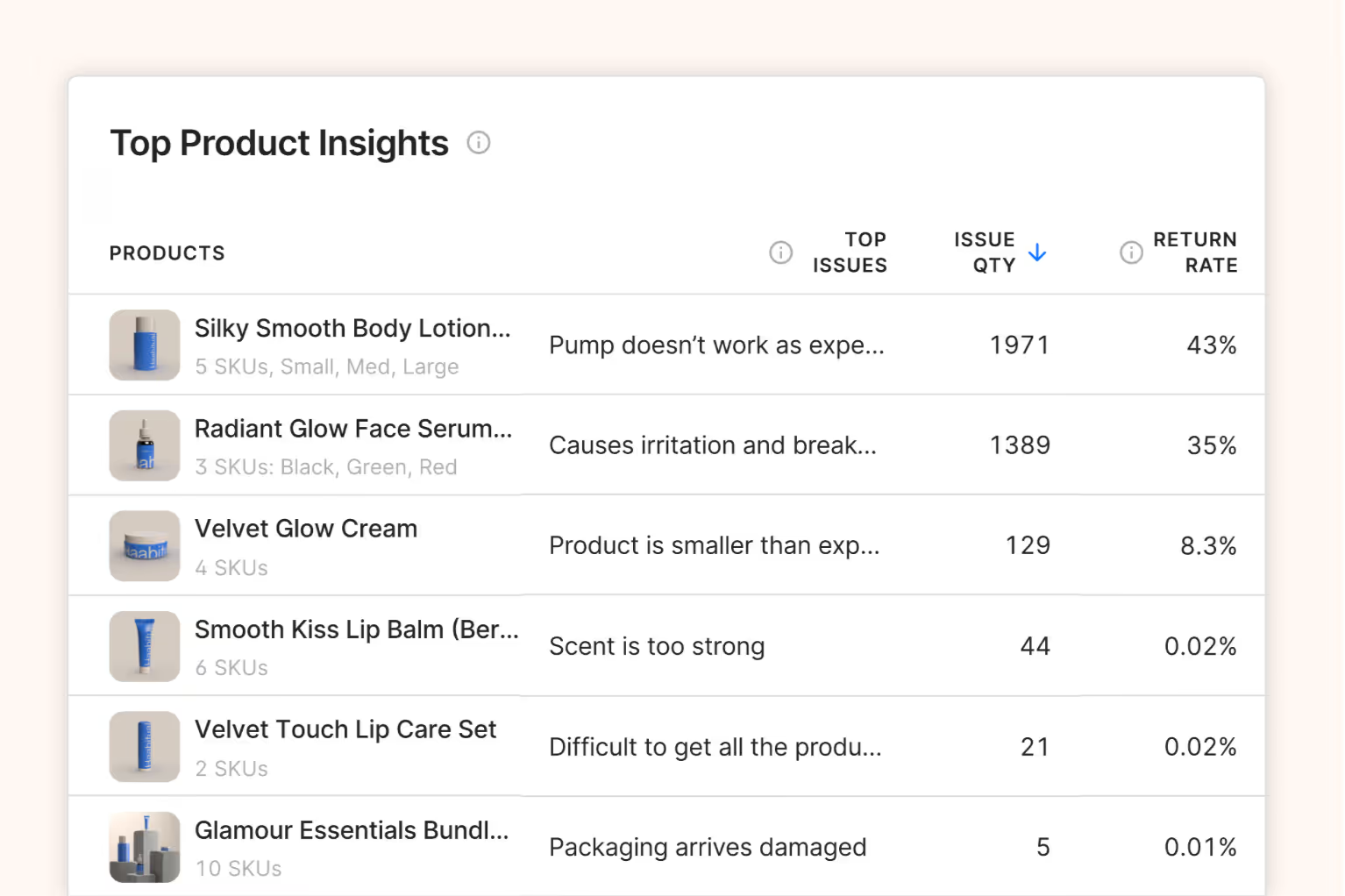
“Sometimes I do it all in the moment. Other times I’ll log it and come back later when I can take the time to do it right.”
By combining frontline feedback with structured ticket views, Katie turned scattered QA into a consistent coaching system — one that ensures SuitShop’s AI Agent keeps getting smarter every week.
Learn from your human agents
One of Katie’s most effective strategies comes from her own team.
Like many CX leads, she noticed that some agents consistently resolved tickets in a single touch. That pattern, Katie realized, wasn’t just a win for customers, it was a roadmap for an AI-driven support strategy.
Her teammate Tacy quickly became her go-to signal for what the AI Agent needed to learn next.
“I pull her tickets often to see what she’s responded with. It helps AI learn from her directly.”
By reviewing Tacy’s ticket history, Katie identified standard replies that didn’t yet exist as macros or Guidance. If Tacy was writing the same sentence repeatedly or copy-pasting a reply manually, that meant it could (and should) be taught to the AI Agent.
She also tracked Tacy’s macro usage rate. If Tacy frequently used a macro for a certain issue, but other agents weren’t, it flagged an opportunity to standardize responses across the team and the AI.
The key insight? If it only takes one touch for a human to answer, the AI can be trained to do it too.
These small efficiency wins added up quickly, especially during peak season, when the ability to automate just a few extra conversations per day created meaningful breathing room for the rest of the team.
Related: How to automate half of your CX tasks
Make your AI sound human (and on-brand)
Automation without brand voice feels robotic. Katie made sure SuitShop’s AI Agent sounded like a natural extension of the team, and that started with a name: Max.
“We get replies like, ‘Thanks Max!’ from customers who think it’s a real person.”
Using AI Agent’s tone of voice settings, Katie went deep on personalization. She customized everything from sentence structure and greeting format to whether or not emojis and exclamation marks should be used (they shouldn’t, in SuitShop’s case).
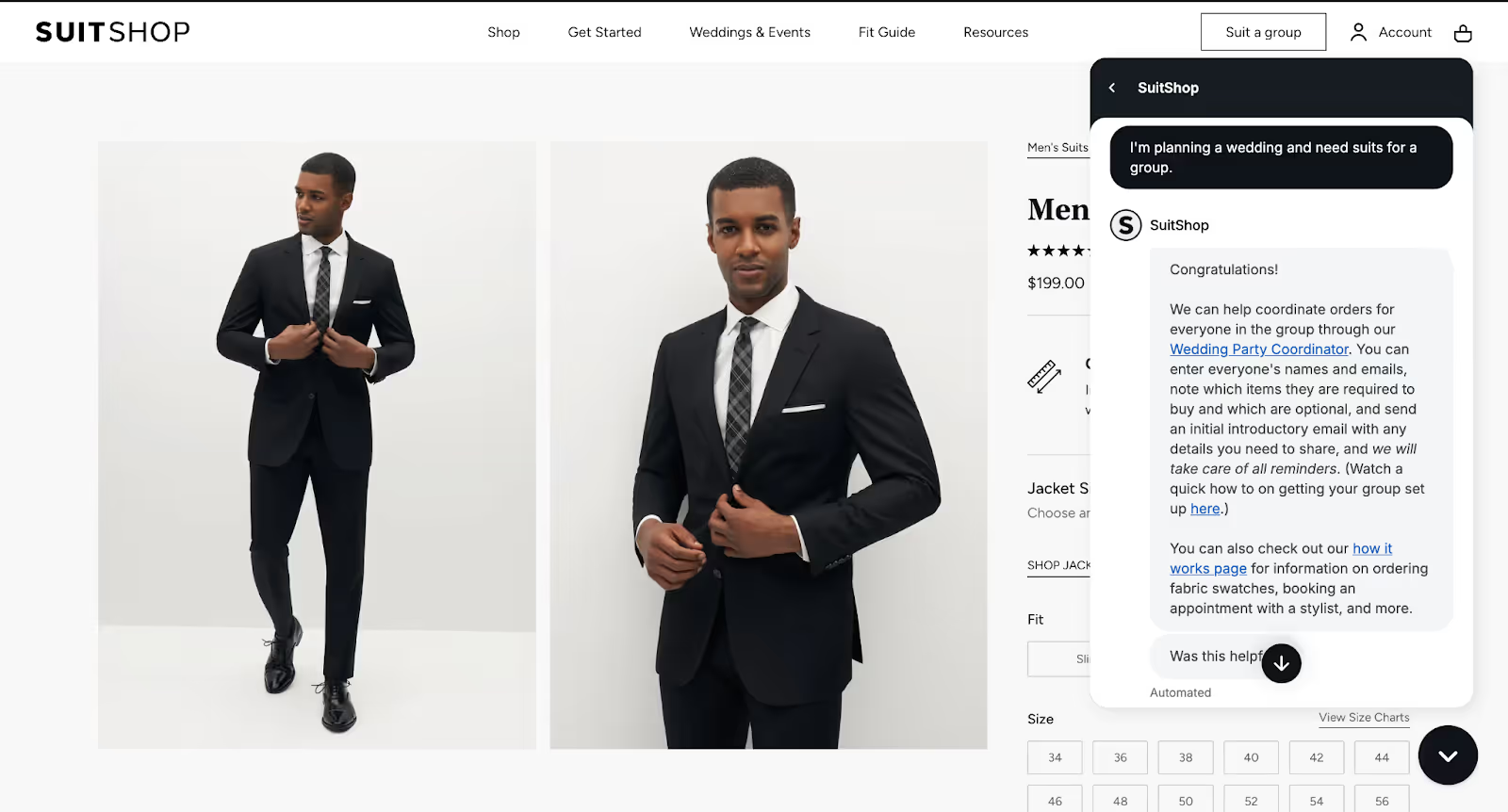
Her AI Agent instructions include clear direction on:
- Tone: Warm, empathetic, clear, especially with high-stress wedding-related issues
- Structure: Shorter responses for chat, slightly more detailed for email
- Dos and Don’ts: Specific words or phrases to use or avoid, pulled from real team responses
- First/last name use: Always first name only, to keep things friendly but respectful
Katie also made sure she instructed AI Agent to acknowledge customer emotions — especially frustration — and to offer reassurance when things went wrong.
And because AI responses are written at lightning speed, she regularly reviewed messages to ensure they didn’t come off as cold or abrupt, especially in sensitive situations like delayed wedding orders or size issues close to the event date.
Live coaching: What it looks like in practice
In the workshop, Katie walked through two real support tickets where AI missed the mark and how she used those moments to improve.
In one case, a customer asked a common question: “The navy suit I’m looking at says ‘unfinished pant hem.’ Will the pants need to be hemmed?”
Despite having help articles and macros explaining this exact issue, AI Agent responded: “I don’t have the information to answer your question.”
That was a red flag.
Katie immediately stepped in to coach the agent by:
- Applying the correct existing resources
- Writing an ideal sample reply as an internal note
- Checking tone, empathy, and phrasing
- Testing the fix by pasting the same question into the test environment
“I like to write a short internal note, so if I see that ticket again, I know exactly how I coached it.”
In another case, AI Agent was incorrectly handing off a sizing question about jacket sleeve length. Katie realized that a previous broad handover topic ("sizing and fit questions") was causing confusion by flagging issues that the AI should have been able to handle.
So she deleted the handover topic and replaced it with a clear guidance article — complete with example questions, macros, and links to sizing resources.
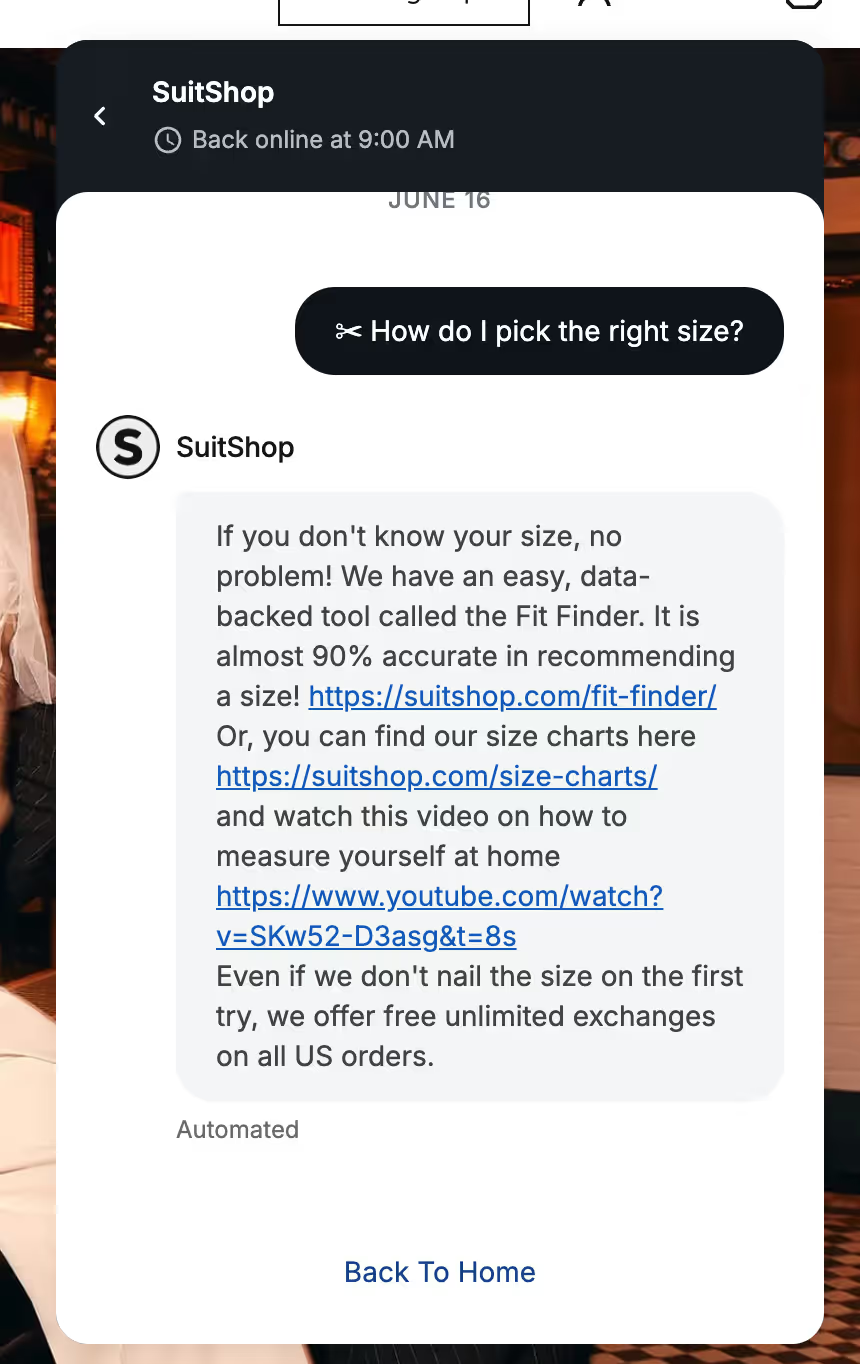
“Once I added specific questions in quotes, it made a huge difference.”
What's next: AI tools that help you scale faster
SuitShop didn’t automate 100% of CX — but that’s not the point. At 30% automation (and growing), Katie gives her team more time to specialize, connect, and handle urgent or emotional conversations with care.
Here’s what Gorgias offers to help as well:
- Optimized intent dashboards: These show the most common topics customers ask about, the AI’s performance on those topics, and how much opportunity there is to increase automation.
- Auto-generated knowledge: Based on your macros, Help Center, and even Shopify data, Gorgias can now draft suggested guidance for your review, making it faster to train your AI Agent without starting from scratch.
- Auto QA: This tool scores every AI (and human) response based on resolution, accuracy, communication, and tone. It gives you full visibility across your team and automations, without needing to review each ticket manually.
Whether you’re just getting started or trying to move beyond basic automation, Katie’s approach proves that coached AI outperforms out-of-the-box tools every time.
Want to coach your AI Agent like SuitShop? Book a demo to see how Gorgias can help you scale smarter.
{{lead-magnet-1}}

How to Drive Growth with an Automated Subscriber Journey
TL;DR:
- Subscribers drive 3x more value than one-time buyers. Subscriptions create ongoing relationships that build loyalty and increase lifetime value.
- Make subscription opt-ins easy and appealing. Use tools like default subscription settings, upsell widgets, and A/B testing to encourage conversions at every step of the journey.
- Retain subscribers by treating key drop-off points as recovery moments. Use win-back campaigns, payment recovery, and personalized support to reduce churn.
- Meet customers where they are with AI-powered tools. Solutions like Gorgias Shopping Assistant and Recharge Concierge SMS provide real-time, contextual support and subscription management.
Vanessa Lopez, VP of Customer Experience at Recharge, recently led a workshop that outlined how brands can transform one-off interactions into rich subscription journeys that increase opt-ins, reduce churn rate, and boost lifetime value (LTV).
Here’s what we learned.
What are the different subscription types?
There are many different ways that you can offer subscriptions. Here’s a rundown of the most common.
Subscribe and save
The most common subscription type is “Subscribe and save.” Instead of making a one-time purchase, customers subscribe to a product and receive it on a different cadence, whether that's weekly, bi-weekly, monthly, or quarterly.
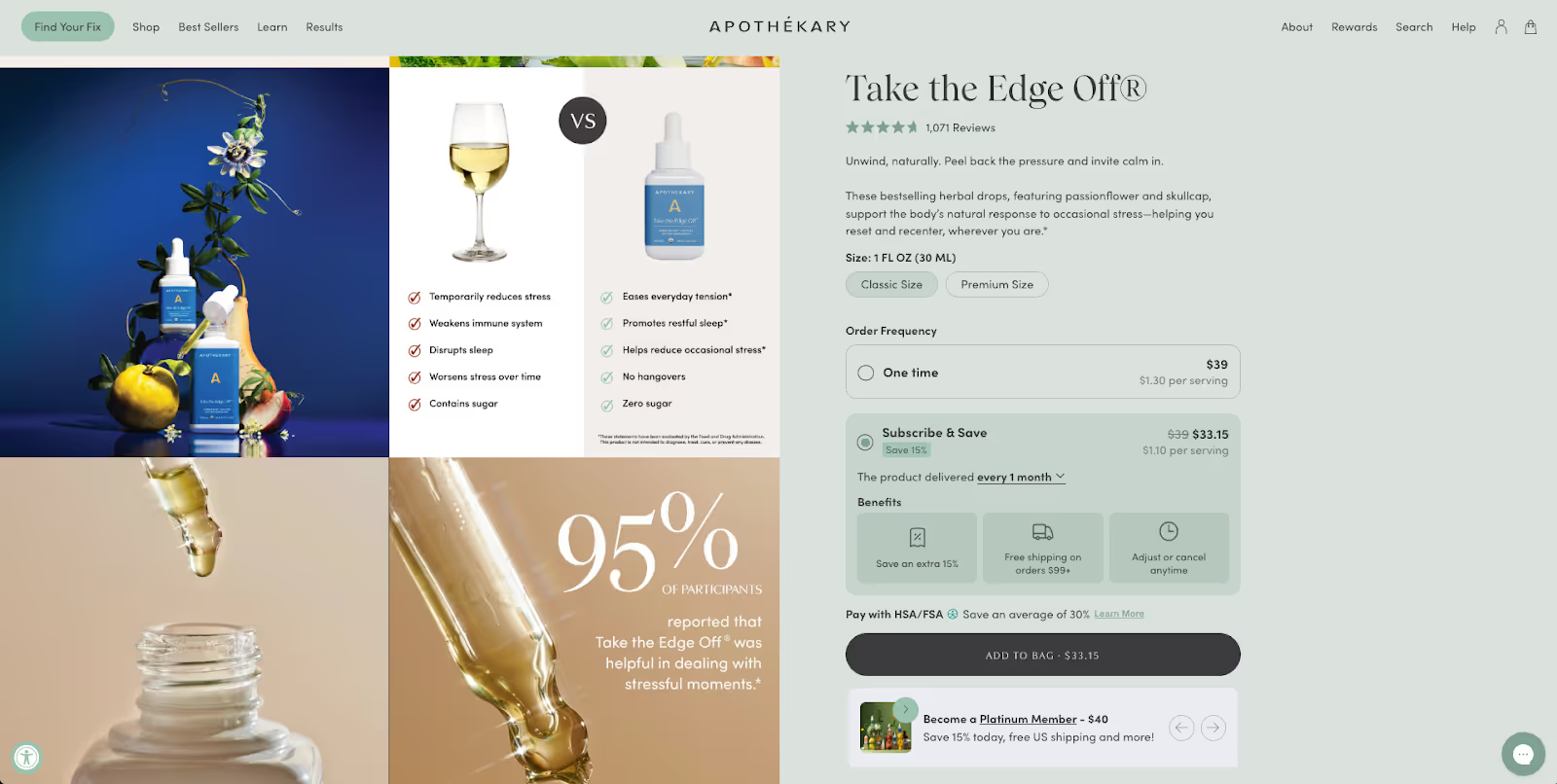
For example, Apothékary offers a Subscribe and Save option for its herbal remedies where shoppers get a discounted rate if they subscribe every one, two, or three months.
Subscription boxes
Subscription boxes ship to customers monthly. Shoppers subscribe over a course of time, like every quarter, six months, or year. For example, CrunchLabs offers a prepaid Build Box option for kids and adults who want to tinker like engineers.
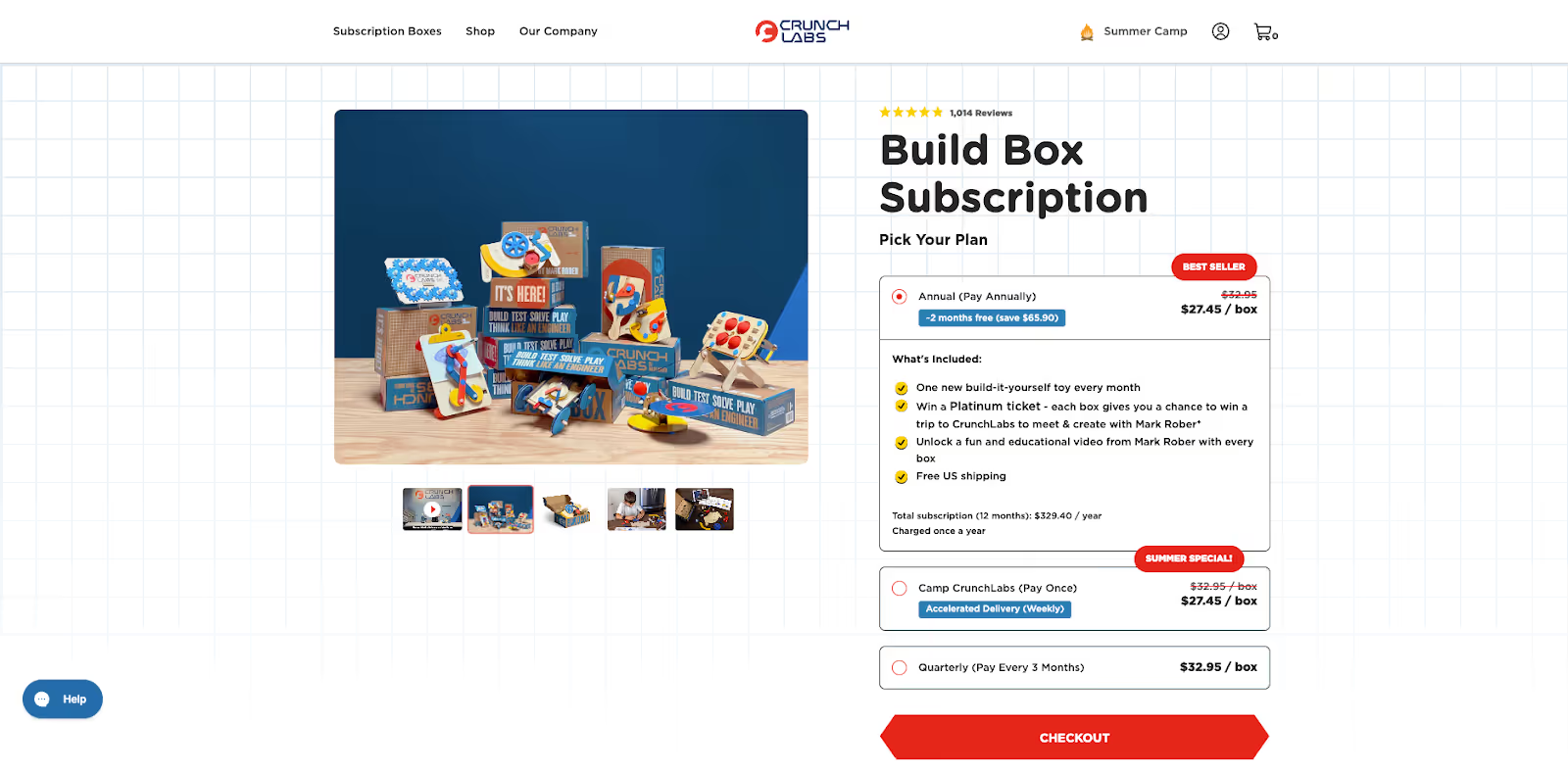
Meal kits
Meal kits are weekly food delivery services that either include pre-packaged ingredients to cook a dish or fully cooked dishes.
Surprise and delight
For brands that are selling higher-cost or unique items, subscriptions to purchase the same product over and over might not be the best way to gain subscribers.
The better option is a curated box, also known as a "subscribe and delight" or “mystery” box. It’s a unique way to cater to customers who prefer trying out different products, rather than receiving the same product on a recurring basis.

For example, premium snack box brand Bokksu specializes in shipping Japanese snacks. Rather than packing the same treats each month, the brand curates different items with every package. This creates both excitement and differentiation each time a customer gets a delivery.
How to drive revenue growth with subscriptions
- Turn interactions into journeys
- Create multiple touchpoints for conversion
- Retain subscribers over time
- Meet customers where they are
- Approach AI as a solution-driver
Subscriptions are the original relationship between a brand and its customer. In fact, subscribers drive three times more value than the one-time buyer. That's because a one-time purchase is really just that—a moment in time—while subscriptions are a journey.
“When you have a customer and they subscribe, you get to see that moment they fell in love with your brand,” says Vanessa. “You get to see when they have those moments where they made you a part of their routine. Every time they engage with you and purchase something new, you learn their rhythms. You learn their preferences. It's impossible to do that with one-time buyers for the most part.”
Subscribers drive three times more value than the one-time buyer, and that's because a one-time purchase is really just that—a moment in time—while subscriptions are a journey.
1) Turn interactions into journeys
Subscribers can only drive growth if you can get those customers to subscribe in the first place. This is what Recharge does: it takes customer interactions and turns them into a customer journey, allowing you to act on those signals in a personal way at scale.
It all starts the moment a shopper browses a product. Each touchpoint is an opportunity to turn that shopper into a subscriber—from the product description page to the subscription widget to checkout.
Vanessa’s tip? Make subscriptions the default option on a product description page. When you present customers with the better and more convenient option, and they see this information at the right time, they're more likely to subscribe.
Put it into practice 💡
Now, it’s time to test. Here's a checklist you can follow to A/B test your subscription journey:
- Test the small details, like button styles, CTA copy, subscribe and save benefits, and their positions on the page.
- Compare different value propositions and discounts.
- Analyze the difference in opt-in and subscriber rates and product performance, and keep iterating.
When customers see the right information at the right time, they're more likely to subscribe. That's because it's the better and the more convenient option.
2) Create multiple touchpoints for conversion
Let's say you have a customer who starts on a product description page. They decide not to subscribe—no worries. You can catch them in the cart.
When they add a product to their cart, you can upsell them with different subscription benefits so they know what they're missing out on. Do it again when they review their cart, and then again when they go to checkout, showing them complementary products that they might be interested in.
And don’t forget to take advantage of that post-purchase "your order is confirmed" high—offer customers cross-sell products, complementary products to their order, or similar items to what they've purchased in the past.
By creating multiple touchpoints for conversion, you’ll increase the possibility that they’ll make a purchase.
Put it into practice 💡
Set up automations in the subscription tool –– like Recharge –– you use. That means adding on upsell and cross-sell tools, and perfecting the times they trigger for customers. Test out different copy and cross-sell/upsell offers to see what resonates the most.
3) Retain subscribers over time
Just as important as acquiring customers is keeping them around.
The Recharge team names three core customer moments that might actually diverge from what brands expect to happen in the customer journey:
- When a payment fails
- When a customer cancels their subscription
- When a customer skips—and keeps on skipping
And while they might seem like hiccups in the process, these moments are actually hero moments. They’re moments that give you the opportunity to actually win those customers back.
Put it into practice 💡
- Prevent cancellations by addressing individual customer concerns at scale with a help desk like Gorgias.
- Set up win-back campaigns. Recharge found that these types of campaigns can convert up to 35% of subscribers by giving them a compelling personalized offer and a straightforward reactivation.
- Recover failed payments to ensure small issues –– like billing and shipping address inconsistencies –– don’t get in the way of your sales.
- Connect all of your customer touchpoints with rewards and referral products.
4) Meet customers where they are
For browsing shoppers, educational and informational resources are the best way to meet their needs, hesitations, and objections.
For regular subscribers, it’s providing them with direct control over their subscription, whenever they want.
The goal is to reach customers where they already are and respond instantly to their needs in a personalized way.

Gorgias’s Shopping Assistant does exactly that—meeting customers where they are by answering customer questions and even initiating conversations based on browsing activity.
This AI sales tool detects a shopper's intent, cart contents, and browsing behavior to initiate conversations, recommend products, and even send discounts as they make a decision.
Modern bidet brand TUSHY saw a 20% increase in chat conversion rate after implementing the tool.
Put it into practice 💡
Decide how you’d like to leverage AI and automation to meet customers where they are. That might be by providing a phone number that customers can interact with via SMS, or implementing a tool like Shopping Assistant to strike up conversational AI chats. Using AI and automation will help you better meet your customers where they are and at scale.
5) Approach AI as a solution-driver
Rather than using AI to come up with problems your brand can solve, Vanessa recommends looking at the challenges your brand has already seen with subscriptions.
The key is to view AI as a tool that drives three core areas:
- Scaling your business without adding headcount
- Reducing churn
- Increasing how much customers spend with you over their lifetime
Vanessa says the most effective strategy starts with leveraging AI-powered tools, such as Recharge’s Concierge SMS.
Typically, SMS tools use template auto responses like, "How do you want to manage your subscription? Type one to cancel, type two to skip." But these aren’t compelling enough for customers to respond. What if they want to do something that doesn't fit in those two options?
Concierge SMS enables brands to build stronger relationships with their customers through conversations powered by pre-trained AI. It personalizes SMS support with customers, so relationships can expand into loyalty.
Put it into practice 💡
Implement an AI-driven subscription management tool that allows customers to interact and ask questions via SMS, rather than only being able to confirm or deny upcoming shipments.
Grow your brand sustainably
Gorgias and Recharge are a powerful combination when it comes to integrating subscription management with top-notch customer support.
With Recharge, efficiently convert one-time buyers into subscribers, retain subscribers through intelligent interventions, and connect every customer touchpoint into one cohesive journey.
With Gorgias, sell more and resolve support inquiries with conversational AI.
{{lead-magnet-1}}

How Do You Build a Support Sales Flywheel? Lessons from 4 Experts
TL;DR:
- Segment customers for personalized support. Use purchase history and behavior data to tailor every interaction, making conversations more relevant and higher-converting.
- Offer onboarding calls for complex products. TUSHY's "Poo-Rus" turned free install calls into a $15 paid service that dramatically boosts customer LTV and retention.
- Pick up the phone strategically. Use voice calls for abandoned carts, stuck tickets, and VIP follow-up.
- Give agents freedom to make judgment calls. Empower your team to bend policies and offer solutions that prioritize retention over rigid rules—confident agents drive more cross-sells.
- Train for helpful selling, not pushy pitches. Use roleplaying to teach agents how to spot buying signals and offer value naturally.
At Gorgias Connect LA 2025, CX leaders from Tommy John, TUSHY, Triple Whale, and Talent Pop shared how support teams solve problems and drive revenue.
This shift, known as the support sales flywheel, doesn’t involve massive overhauls or shiny new tools. Instead, it means doing the small things exceptionally well, like picking up the phone, empowering agents to make judgment calls, and adding a personal touch where others automate.
These brands have shown that when support teams focus on consistency, connection, and conversion, the results compound. Every thoughtful interaction spins the flywheel faster, boosting loyalty, LTV, and revenue.
Ahead, we’re breaking down the most actionable takeaways so your team can start building its own support-led growth engine.
Watch the full panel here:
5 tactics that power the support sales flywheel
From scrappy install calls to AI-powered training, these CX leaders aren’t only talking about driving revenue, they’re doing it. Here’s how they’re turning support into a sales flywheel, and the tactics your team can start testing today.
1. Personalization at scale starts with smart data
“Customer service done right is actually a great source of revenue.” That’s how Tamanna Bawa, Tech Partner Manager at Triple Whale, kicked off the conversation on how data can transform CX from reactive to revenue-driving.
She advises segmenting customers based on purchase history and behavior to deliver more personalized, higher-converting interactions.
In a market where margins are razor-thin and ad costs are high, Tamanna emphasized that “incremental gains from personalization are the difference between companies that are thriving and the ones that are just surviving.”
Steal this strategy
- Segment customers based on behavior and purchase history using your helpdesk, CRM, or analytics tool.
- Give agents access to this data so they can personalize every interaction.
- Use macros that adapt based on customer segments, like VIP status, product interest, or past issues.
- Focus on relevance over volume: one well-timed, tailored message converts better than a generic one.
2. The power of onboarding calls
What do you do when your hero product needs a cultural shift as much as it needs installation instructions? If you’re TUSHY, you send in your “Poop Gurus.”
Ren Fuller-Wasserman, Senior Director of CX at TUSHY, shared how her team launched a scrappy, free CX-led service that has now become a legendary video install program to help customers set up their bidets.
The real value wasn’t just tech support. As Ren put it, “It wasn’t about the actual install process, it was the encouragement they needed to change culture.” These calls sparked deeply personal moments (yes, even with cats and toddlers wandering in) and created the kind of emotional connection customers never forget.
Today, that service has evolved into a $15 paid add-on at checkout, and the customers who use it have significantly boost LTV and retention. It’s a masterclass in turning support moments into revenue through genuine human connection.
Steal this strategy
- Identify a product or feature your customers often hesitate to use, install, or fully understand.
- Offer free, low-lift onboarding calls via Zoom or Google Meet to guide them through setup or usage.
- Track LTV, CSAT, or repeat purchase rates for those who opt in.
- If it drives results, package it as a paid add-on at checkout or use it to surprise and delight key segments.
- Use simple tools like Calendly and Typeform to automate scheduling and reduce lift on your team.
3. When in doubt, pick up the phone
Phone support is back, and it’s becoming one of the most effective ways to turn conversations into conversions.
Ren from TUSHY swears by it. Her team uses customer phone numbers from abandoned carts to reach out directly. “You can send a hundred emails,” she said, “but a voicemail from a real person cuts through the noise.” Even if customers don’t answer, the fact that a brand called is memorable, and often enough to drive them back to checkout.
Max Wallace, the Director of CX Tommy John echoed the value of voice. His team recently implemented Gorgias Voice, using it to track conversion rates by agent. That visibility helps them identify what top performers are doing differently and replicate it across the team. “By the end of a tough call, customers often apologize for how they started. You can’t get that kind of de-escalation over email.”
In a world where inboxes are crowded and chat fatigue is real, a real voice builds real trust and real revenue.
Steal this strategy
- Start small: offer limited phone hours once your chat and email support are dialed in.
- Use phone strategically—for abandoned cart outreach, stuck tickets, or VIP follow-ups.
- Track call outcomes with tools like Gorgias Voice to see which agents are converting.
- Train agents to de-escalate and personalize through roleplaying or AI-based call simulations.
Pro Tip: Don’t rush into phone if your other channels aren’t dialed in. “Master email and chat first. Then, start with limited phone hours. Taste it before scaling it,” said Armani Taheri, the co-founder of TalentPop.
4. Trust your team to use their judgment
For Max at Tommy John, revenue-driving support starts with two things: deep product knowledge and the freedom to bend the rules.
“We have five different fabrics for men’s underwear alone,” Max shared. To help customers choose the right one, agents need firsthand experience. That’s why Tommy John sends new products directly to the support team, so they can offer real, personalized recommendations like “Try Second Skin instead of Cool Cotton.”
But product knowledge is only half the equation. The other half is empowering agents to make judgment calls. Tommy John’s “Best Pair Guarantee” allows customers to try a product and get a refund or replacement if it’s not the right fit.
Agents are trained to prioritize retention, offering replacements instead of refunds, recommending better-suited products, and using their own discretion to keep customers happy.
As Max put it, “We don’t have really strict policies… we want them to use their best judgment.” That confidence translates into smoother resolutions, more cross-sells, and customers who stick around.
Steal this strategy
- Send new or popular products to your CX team so they can speak from firsthand experience.
- Build simple product cheat sheets or comparison guides to help agents make tailored recommendations.
- Give agents clear guidelines—but also the freedom to make judgment calls when it comes to refunds, replacements, or policy exceptions.
- Let your team know it’s okay to “bend the rules” if it means keeping a customer happy.
- Track outcomes like retention and CSAT to show how empowered agents directly impact loyalty and LTV.
5. Training teams to sell without the push
How do you train outsourced agents to drive revenue, without sounding like a sales team? According to Armani Taheri of TalentPop, it starts with confidence and context.
“You have to tailor-fit the training approach to each brand,” he explained. That means grounding agents in product knowledge, tone of voice, and customer journey before they ever interact with a shopper.
One of the most effective tactics is roleplaying. Armani’s team uses both live roleplays and AI-powered chat simulations to prepare agents for real conversations, pre-sales, post-sales, and everything in between. Tools like Replit and Lovable help create lightweight, brand-specific training environments agents can practice in at their own pace.
The goal isn’t to turn CX reps into hard sellers. It’s to give them the confidence and consistency to recognize revenue opportunities, and act on them in a natural, helpful way.
Steal this strategy
- Start with the basics: make sure agents understand your product, tone of voice, and customer journey.
- Roleplay low-pressure scenarios, then layer in more complex ones.
- Try AI-powered training tools like Replit or Lovable to create brand-specific simulations agents can practice anytime.
- Emphasize helpfulness over selling: coach agents to spot buying signals and offer value, not push products.
- Review transcripts together to highlight great conversations and show how small shifts lead to better outcomes.
Tools to power your flywheel
Ready to turn your CX team into a revenue engine? Here are some of the tools mentioned by the panelists that help make it happen:
- Gorgias Voice: Track revenue by agent, spot top performers, and improve conversion rates across the team.
- Flip CX: Automate common phone interactions with AI-powered voice support.
- Kixie: Drop voicemails, integrate with Klaviyo and Shopify, and build smart call queues for abandoned cart outreach.
- Calendly + Typeform: Scrappy, low-lift tools for scheduling paid or free support calls that drive LTV.
Whether you're scaling phone support or experimenting with post-purchase outreach, the right tools make the flywheel spin faster.
Your CX team might be your best-kept sales secret
They’re on the front lines with your most engaged customers, answering questions, easing doubts, and uncovering what really drives purchases. With the right tools and training, they resolve tickets and help close the sale.
With tools like Gorgias Voice, it’s easier than ever to connect the dots between conversations and conversions.
Want to see how your CX team can help drive growth?
Book a demo to see how Gorgias Voice powers sales through support.
{{lead-magnet-1}}

Every Successful Marketing Campaign Starts with a Customer Question
TL;DR:
- Start with your CX team—they know what customers are asking. Their insights reveal what’s confusing, what’s converting, and what’s causing returns before marketing ever gets involved.
- Turn pre-sale questions into better messaging. Use common support queries to improve landing pages, product descriptions, and emails so customers feel confident enough to convert.
- Your best-performing products aren’t always the most hyped. Let real customer comments guide your messaging by identifying what people rave about in chats and reviews.
- Customer confusion and returns usually stem from messaging gaps. Fix product pages, policies, and descriptions to better reflect what people need to know upfront.
Your CX team talks to customers every day. They know what’s confusing, driving purchases, and causing returns, because they hear it firsthand.
But all too often, those insights stay siloed in support tickets and live chat transcripts instead of informing the campaigns that shape the customer journey.
This post is here to change that. We’re breaking down the most valuable questions marketing teams should be asking their CX counterparts. When marketing and CX work together, you get more relevant messaging, smarter product positioning, and campaigns that convert.
Whether you’re planning a big seasonal push or just want to improve product education, this is where to start.
{{lead-magnet-1}}
1. What do customers ask about before buying?
Your CX team knows what makes shoppers hesitate. They’re the ones fielding questions like: Does this come in a larger size? Is it final sale? Will it arrive in time?
Beyond being pre-sale inquiries, they’re signals. They reveal what your customers care about most, and where your messaging may be falling short. When marketing teams tune into this, they can proactively address objections in landing pages, product detail pages (PDPs), emails, and top-of-funnel content.

At luxury jewelry store Jaxxon, Director of Customer Experience Caela Castillo saw firsthand how important it is to address these questions early.
“Chat used to be a support tool for repetitive questions and problem-solving, but now AI Agent takes care of that for us,” she said. Once those friction points were handled upfront, the CX team could focus on more meaningful conversations, and conversions improved.
And when AI recommended the wrong products? Conversions dropped. It was a clear signal that relevance matters, especially before the sale.
Ask your CX team:
“What do customers most often need to know before they buy, and how can we answer that earlier in the journey?”
2. What product do customers rave about—and why?
Your best-selling product isn’t always your hero product. Sometimes, it’s that under-the-radar item that customers can’t stop talking about. The one that shows up again and again in reviews, chats, and post-purchase surveys.
The insight is gold for marketers. The key is to find out why people love it. Is it the fit? The feel? The results?
At online fashion brand, Princess Polly, Alexandria shared that her team expected Gen Z shoppers to lean on AI for recs, but what really influenced them was customer feedback. Reviews, not bots, built trust. That’s why campaigns built around real customer language and experiences often outperform the most polished product copy.
Shopping Assistant can turn those rave reviews into real-time action. It highlights top products using your Shopify product catalog to make personalized recommendations, proactively assists shoppers by using behavior signals, and even offers tailored discounts when they’re ready to convert. That means less guesswork, greater relevance, and an easier path to purchase.

Ask your CX team:
“Which product do customers rave about most, and what exactly are they saying?”
3. What product causes the most complaints?
When customers are frustrated, it’s easy to blame the product. But in many cases, the issue isn’t quality, it’s communication.
At Shinesty, a men’s underwear brand, Molly Kerrigan, Senior Director of Retention, observed that high return rates often stemmed from unmet customer expectations.
She noted the importance of maintaining clear and consistent communication as the company grows, “We get a lot of praise from our customers, and they talk highly of our CX team after 1:1 interactions. We can’t lose that as we scale.”
Molly notes that using Gorgias AI Agent enables Shinesty’s customers to receive quick answers, freeing her team's time for more complex or sensitive issues.
Similarly, Princess Polly saw that delivering a standout customer experience meant being fast, consistent, and helpful at every stage. After switching to Gorgias, their support performance improved dramatically:
- 80% decrease in resolution time
- 95% decrease in first response time
- 40% increase in efficiency
Before changing the product, try updating the messaging. Use insights from CX to rewrite descriptions, add size guides, include user-generated content, or even build a quick-fit quiz. Small tweaks help set clearer expectations and reduce unnecessary returns.
Ask your CX team:
“Which products are driving the most complaints, and what do customers wish they knew before buying?”
4. What confuses customers the most?
Confusion is a conversion killer. If a customer isn’t sure about how something works, what’s included, or whether it’s right for them, they’re more likely to bounce.
That’s why it pays to ask your CX team where customers get stuck. Is it a product feature that needs more context? A vague store policy? A missing detail on a bundle?
The good news is that most confusion is fixable. Start with the following steps:
- Simplify your product pages
- Add quick-hit FAQs to your emails
- Use plain language and real examples
If you’re using Shopping Assistant, you can go even further. It can detect when shoppers are hesitant and provides real-time nudges. Like an assistant who knows all your needs, Shopping Assistant automatically surfaces the questions customers are likely to ask when evaluating a product, so they’re equipped with the clarity they need to proceed to checkout.

TUSHY, a modern bidet brand, faced similar challenges. As bidets aren't mainstream in North America, shoppers often had concerns about product compatibility and installation. They’d ask questions like:
- Will a bidet fit my toilet?
- Is installation complicated?
- Which bidet is right for me?
Without immediate answers, many potential buyers would abandon their purchase. To address this, TUSHY implemented Shopping Assistant, providing instant support. Taking this approach resulted in an 81% higher chat conversion rate compared to human agents and a 13x return on investment.
“The Shopping Assistant has been a game-changer for our team, especially with the launch of our latest bidet models. Expanding our product catalog has given customers more choices than ever, which can overwhelm first-time buyers. Now, they’re increasingly looking to us for guidance on finding the right fit for their home and personal hygiene needs,” said Ren Fuller-Wasserman, Sr. Director of Customer Experience at TUSHY.
Ask your CX team:
“Where do customers get confused most often—and how can we clear that up sooner?”
5. Which products are frequently bought together?
Your CX team picks up on patterns that analytics sometimes miss. They hear which items customers ask about in the same chat, which products get added to carts together, and which pairings people reorder time and time again.
That intel is a goldmine for bundling and upselling. It helps you build smarter campaigns that feel relevant and drive real value.
Zoe Kahn, owner of Inevitable Agency and former VP of Retention and CX at Audien Hearing, emphasizes the importance of using AI to enhance customer interactions.
“A lot of that revenue was potentially missed revenue because these were customers sitting on the site, asking questions about the products, and wanting an answer now so they could purchase…Now, AI can answer those questions immediately and convert those customers.”
With Shopping Assistant, you can act on these insights in real time. It will surface personalized product pairings, bundle suggestions, or accessories based on customer behavior. All before they hit the checkout page.

6. Which products lead to the most returns, and why?
Returns cut into your margins and chip away at trust. Most of the time, they’re not caused by poor-quality products. They happen because expectations weren’t met.
Your CX team already knows which items come back the most and why. Maybe the color doesn’t match the photos. Perhaps the fit runs small, or the product description left out a crucial detail.
Instead of pushing the product harder, reframe how you present it. Add real customer photos. Include fit notes or a sizing chart. Call out anything that might surprise the customer post-purchase. A little clarity upfront goes a long way in reducing returns and boosting retention.
At Pepper, an intimates brand specializing in bras for small-chested bodies, they recognized the importance of pre-sale education. When customers have sizing questions, their AI Agent, Penelope, can provide immediate assistance.
“Penelope takes the information we give her and responds better than a Macro. She tailors it so that it sounds like a natural conversation between two people,” said Gabrielle McWhirter, CX Operations Lead at Pepper.
By proactively providing instant support, Pepper improved customer satisfaction and saw an 18% uplift in average order value.
Ask your CX team:
“Which products get returned the most—and what could we do upfront to change that?”
CX + marketing = smarter campaigns, better results
Before you launch your next campaign, start with a quick sync with your CX lead. They already know what your customers need to hear. You just have to ask.
From fixing messaging gaps to surfacing the right products at the right time, these insights help you connect with customers in personal, timely, and relevant ways.
Tools like Shopping Assistant make it easier than ever to act on this data in real time. You can turn CX knowledge into dynamic recommendations, personalized nudges, and smarter discounts.
Ready to see how you can improve your online shopping experience? Book a demo to see how Gorgias Shopping Assistant engages customers in real-time.

Building delightful customer interactions starts in your inbox


